个项目 projects for
篇文章 articles for
名合伙人 principals for
2018引力场:城市微空间计划工作营评图会
Gravitational Field 2018: A Proposal Evaluation Meeting of the Work Camp of the Urban Micro Space Revival Plan
2018.09.14
2018年9月6日下午,由GOA大象设计与Let`s Talk论坛、喜布特展共同举办的“2018‘引力场’——城市微空间计划工作营”评图会在中国美术学院12号楼举行。在本次评图会中,来自同济大学、东南大学、中国美术学院三所高校的六名参赛选手带来了各自的参赛方案,并同在场15位评委们展开了精彩的思维碰撞。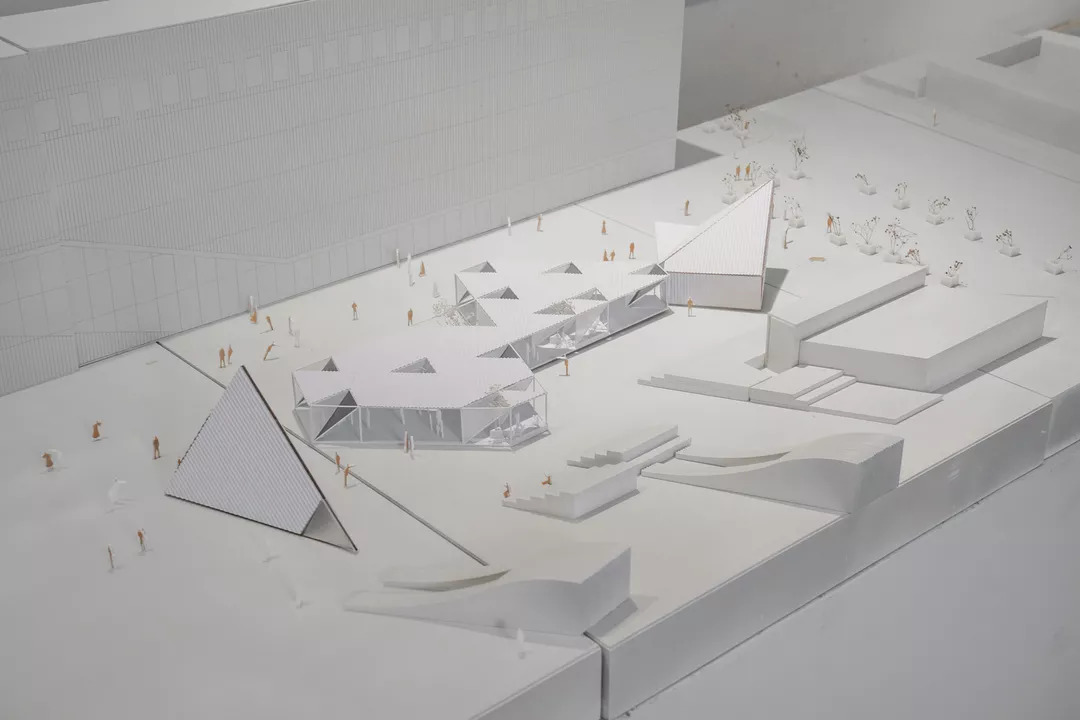
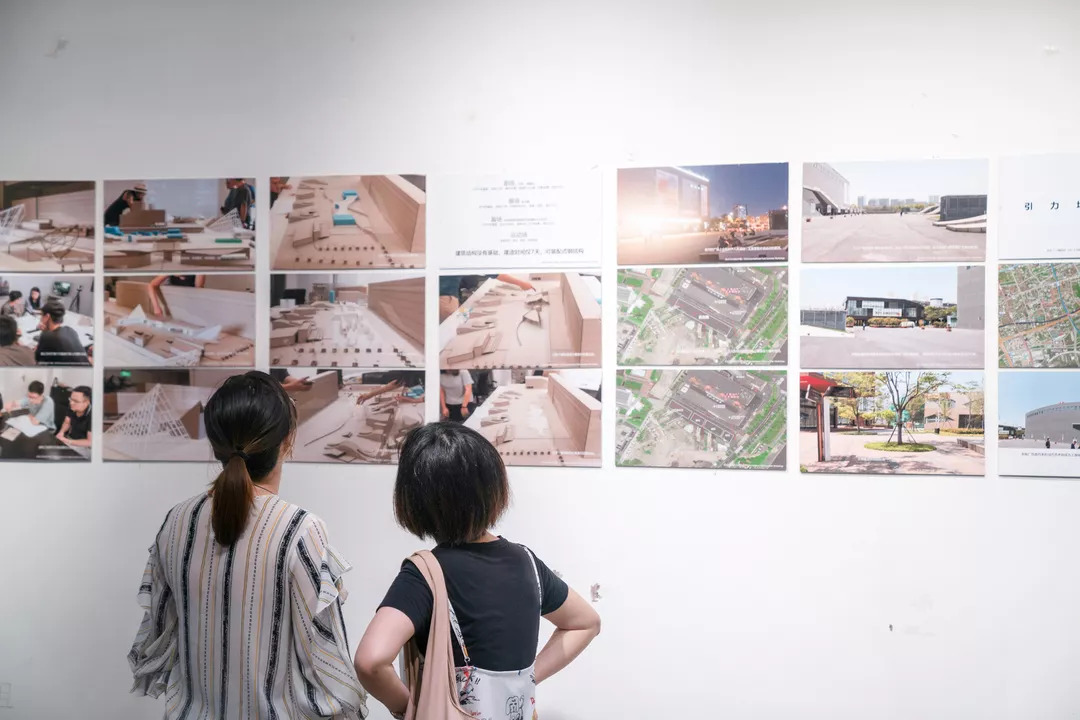
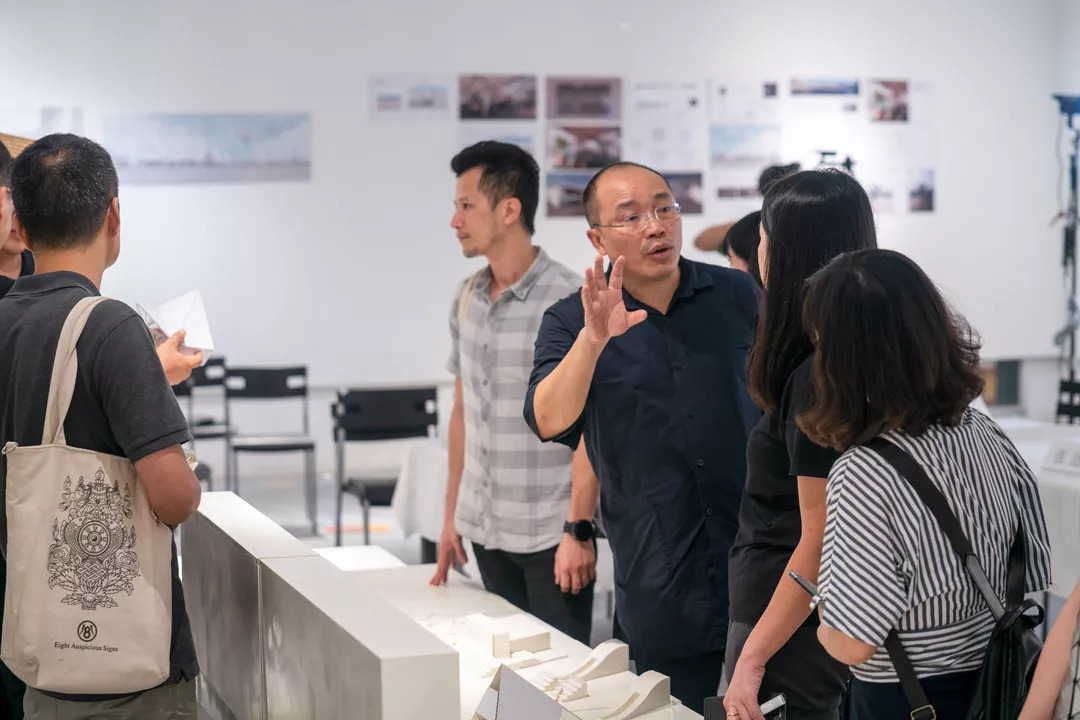
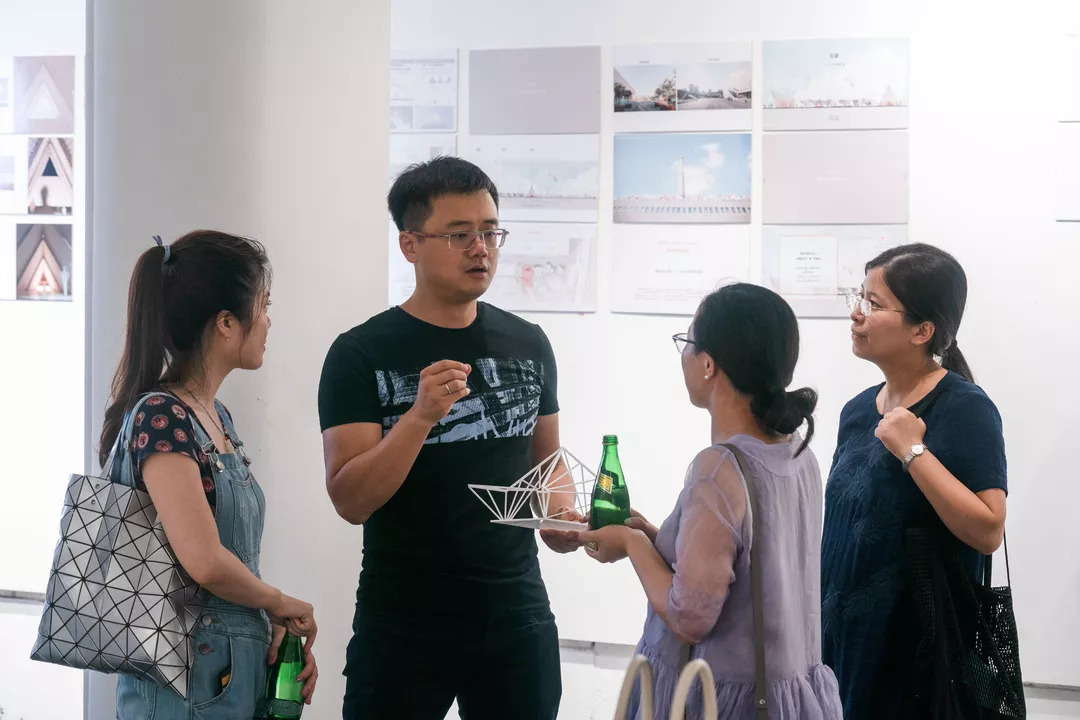
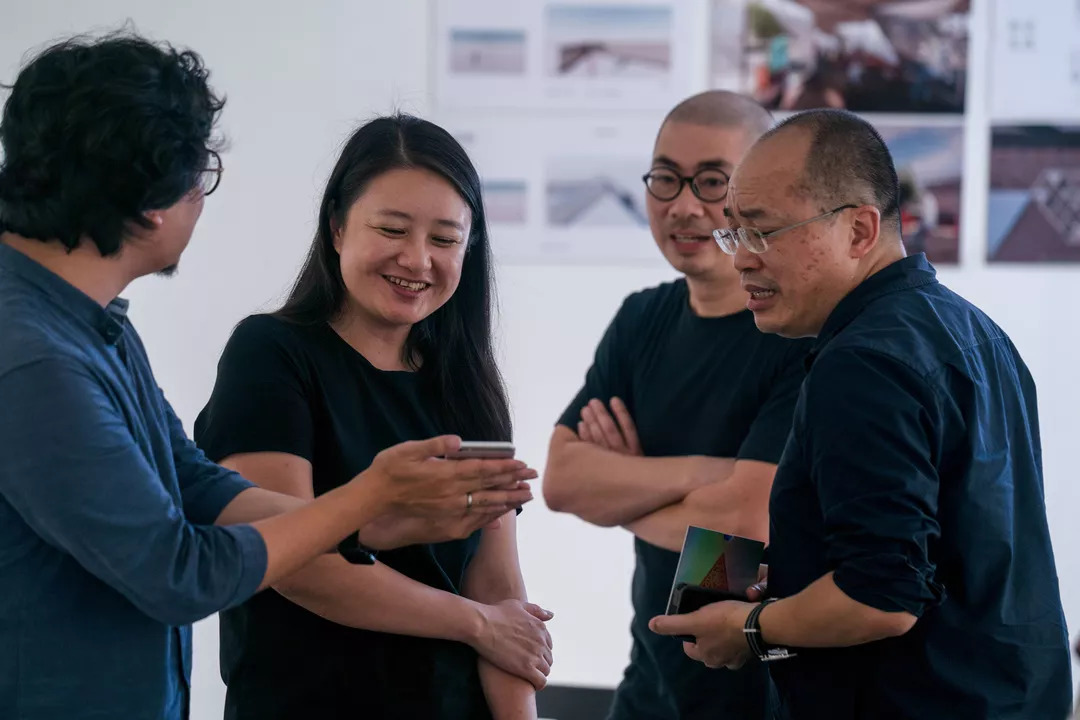
“引力场”活动简介
城市微空间复兴计划
“引力场”
2018工作营
引力场——建筑艺术与公共文化的多场耦合”是由GOA大象设计发起的系列活动,迄今已成功举办两届。GOA大象设计希望通过特定公共空间改造项目的研究、建造过程,发现和培养未来优秀青年建筑师,为他们提供展现创造力的平台;同时,建成项目将成为融合社区活动、艺术表演、亲子游乐等多功能于一身,激发街区活力的“城市引力场”。
2018年GOA大象设计与Let`s Talk论坛联合发起“2018引力场”工作营,共同延续对城市更新的关注。本次活动邀请的评委超过学员1倍多,这样选择为的是最终的作品能有一个更经得起推敲的呈现。同时,这种实际搭建和院校合作的方式也是对现有建筑学教学方式的一种积极探索。GOA大象设计和众位知名建筑导师将参与者提供指导,成果将于11月初在上海当代艺术博物馆(PSA)前广场搭建呈现,并有一系列学术及公众活动随之展开。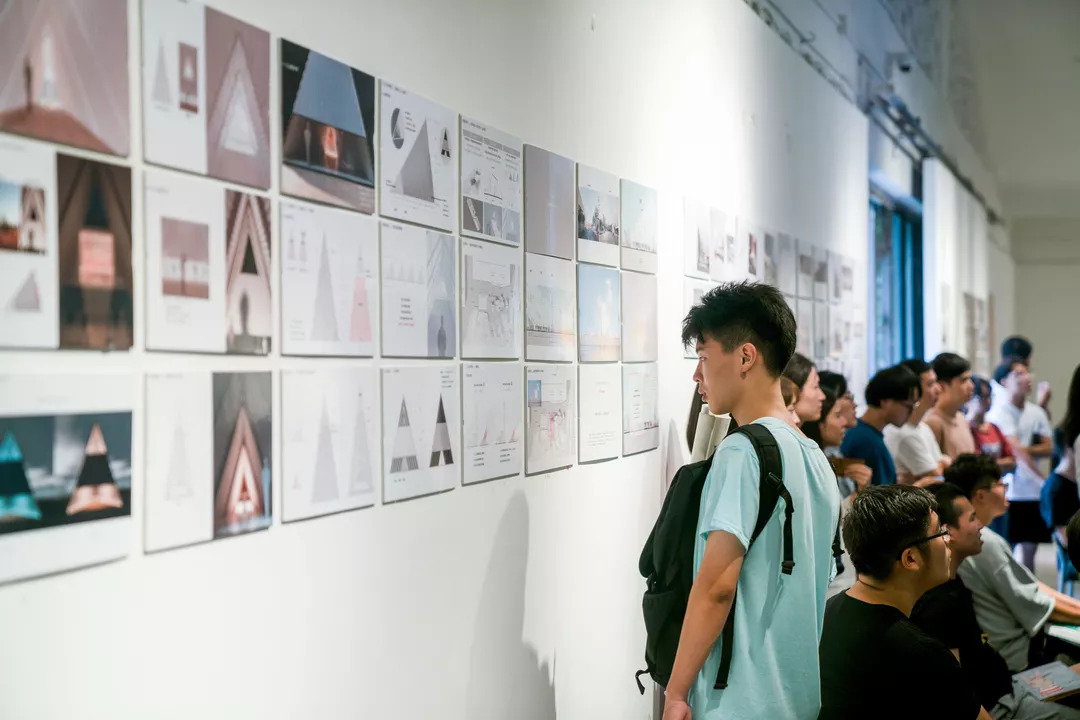
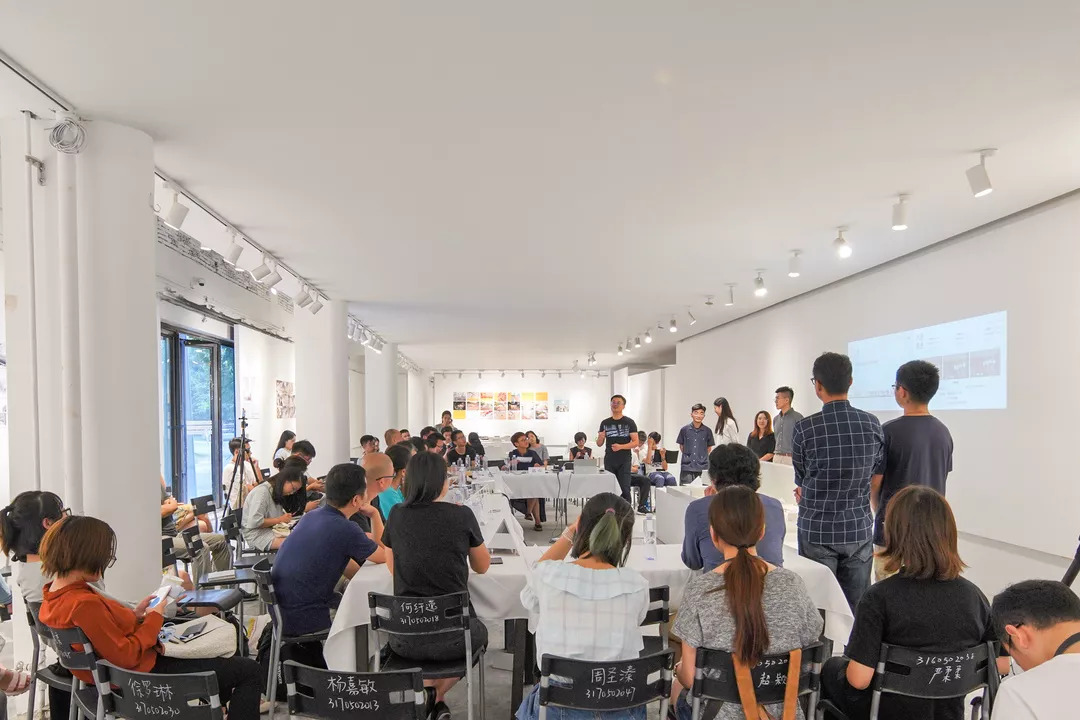
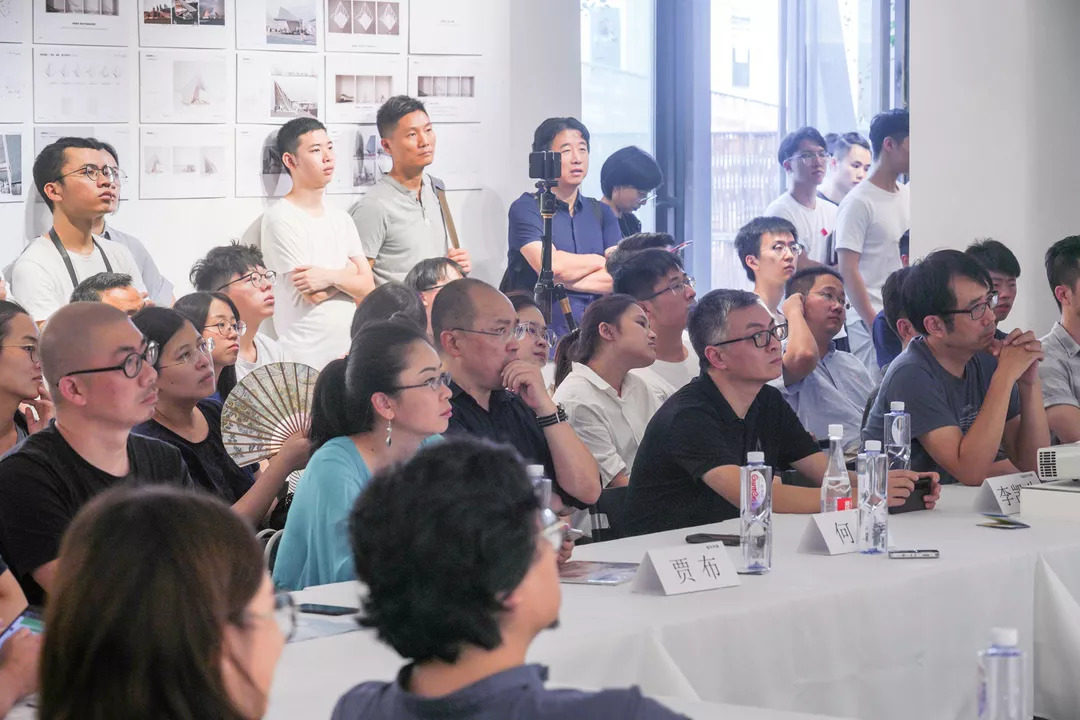
“2018‘引力场’——城市微空间计划工作营”评图会现场
2018“引力场”
城市微空间计划工作营
评图会现场回顾
“引力场”活动需求介绍
贾 布
喜布特展创始人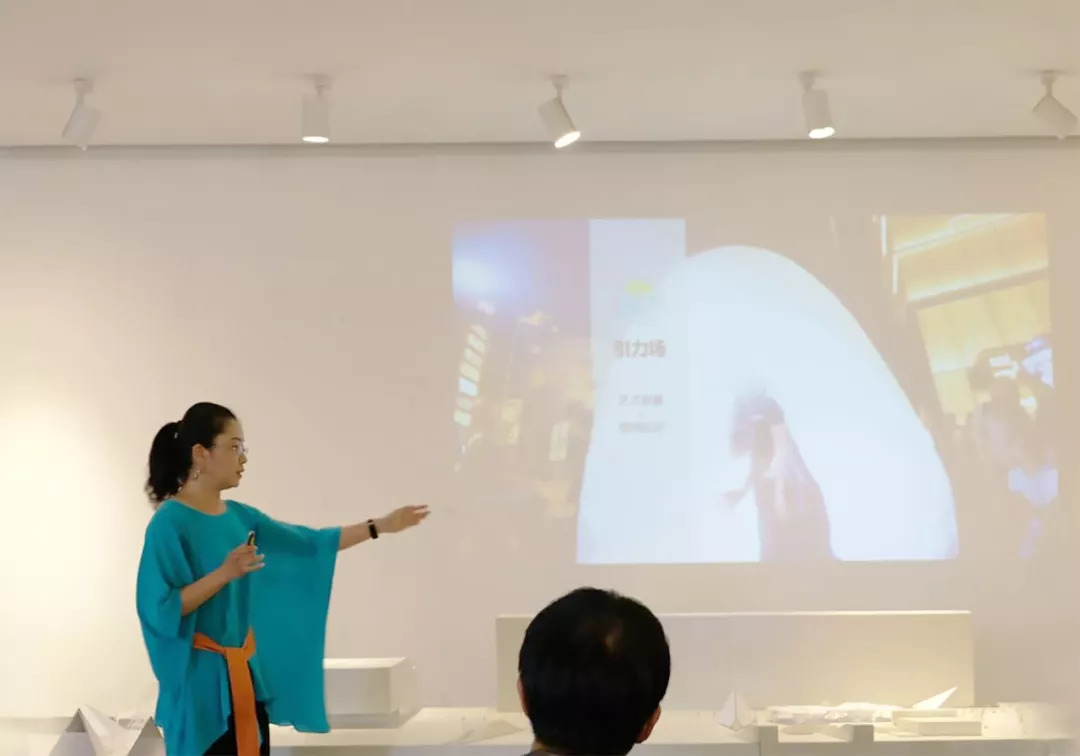
“引力场”活动始终坚持的两个核心要件:艺术装置和现场活动。作为一个公共艺术品,必须符合公众审美标准,同时能满足使用要求。
- 场地升级:今年的场地位上海当代艺术博物馆(PSA)门口的空地,面积达2300平方米。
- 展场要求:今年我们将引入新的展览形式“闪电展”,即每天换一个展览,10点布展,19点撤展,物料不能过夜,要求艺术家使用轻质作品。因此引力场的空间也要匹配布展和撤展需求,展览照明以自然光为主。
- 剧场要求:休息、活动、小型讨论会
今年11月10日PSA将举行上海双年展,该展在全世界范围内都具有很大影响力,到时将会有大量人流在我们这个空间停留。
设计条件分析
王 彦
同济大学建筑与城规学院客座教授
GOA大象设计总建筑师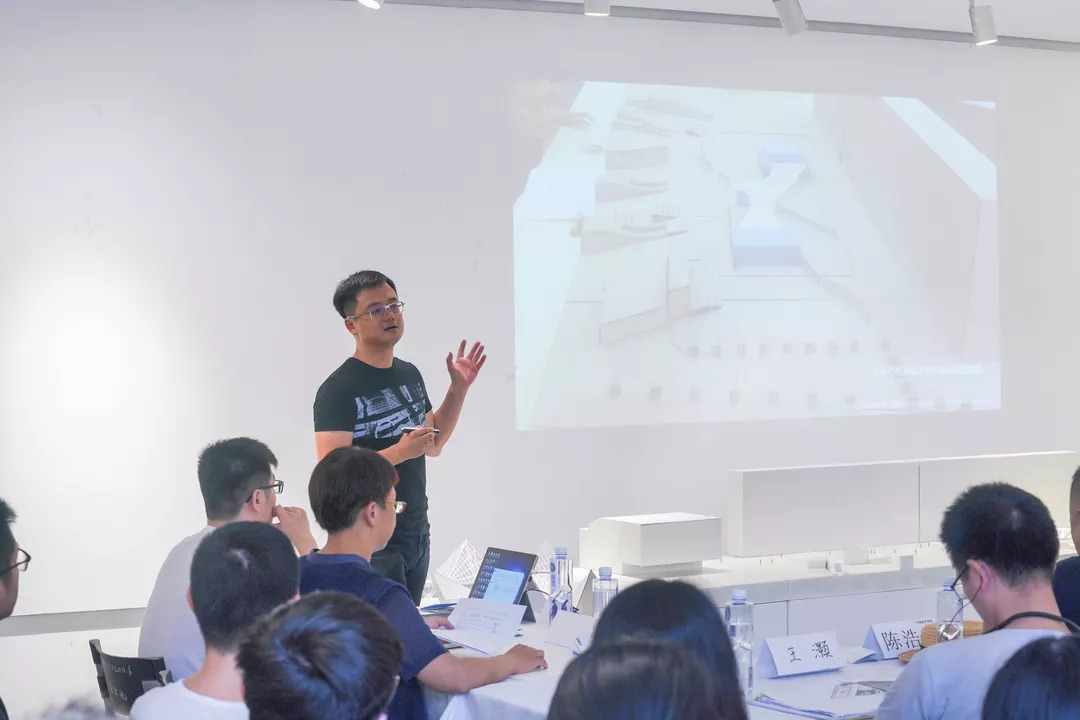
PSA是上海最具影响力的当代艺术场馆,但它门前的场地从未有任何活动发生,该土地管理使用权不属于PSA,而是属于近旁的世博最佳实验区(现为办公园区)。白天办公人群不会到这个场地来,晚间周边居民会在这里停留,但由于没有任何设施,人流属于无组织状态。这里紧邻黄浦江,由于去年上海市黄浦江沿岸贯通工程完成,滨江慢跑成为上海市民的一大爱好。夜跑的人很多,但同样不会特意到这块场地来活动。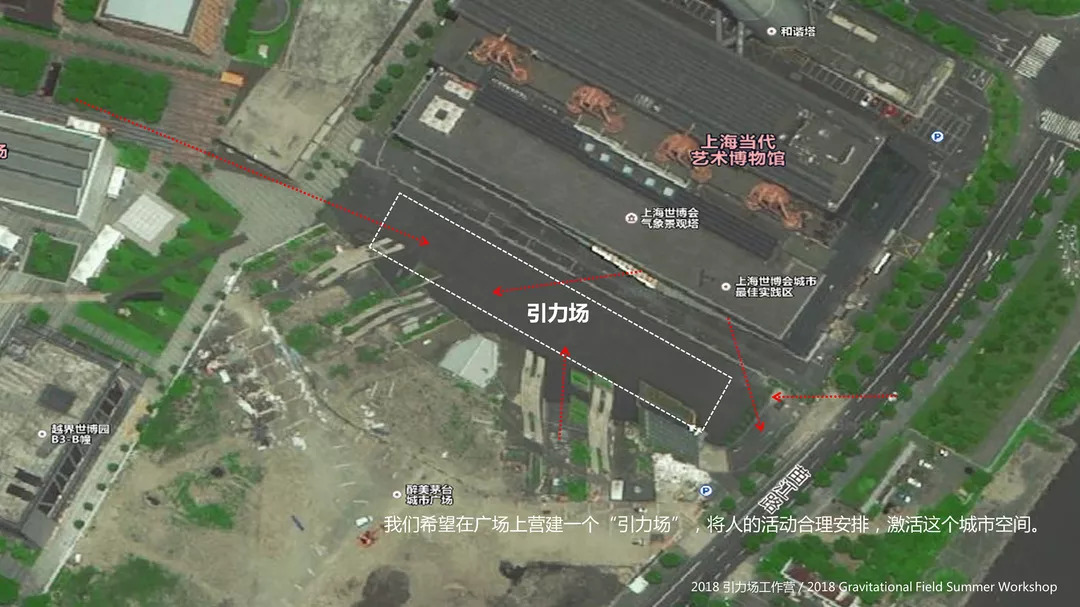
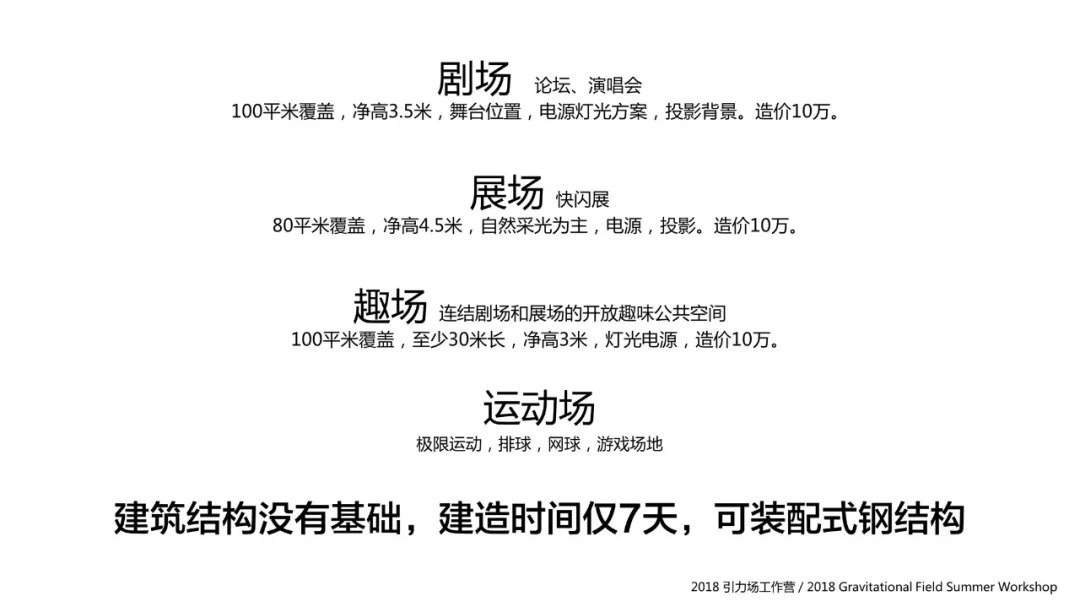
营员汇报
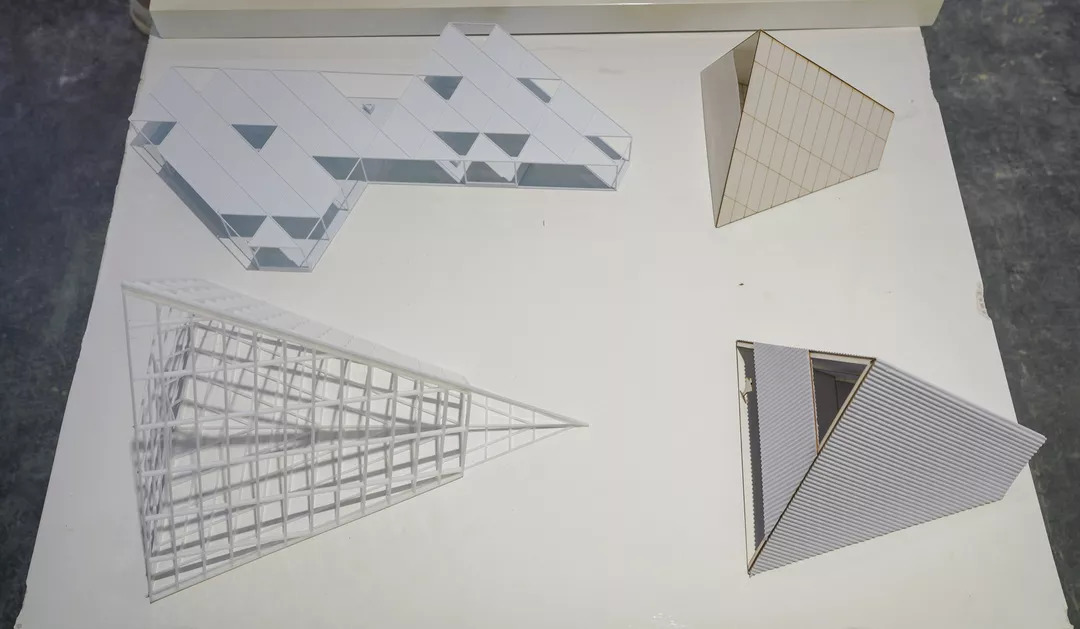
本项目强调与社会联系,从挖掘场地潜力出发,为社区提供更多活动交流的可能性,创造独特愉快的空间体验。本项目将于11月11日开幕,为该地区注入强劲活力。来自东南大学,同济大学,中国美术学院三校的6位同学在建筑、结构、施工、材料多工种顾问指导下,通力合作紧张完成方案。
小组一
>>> 聚散——剧场 <<<
张旭、乔润泽
东南大学建筑学院大四学生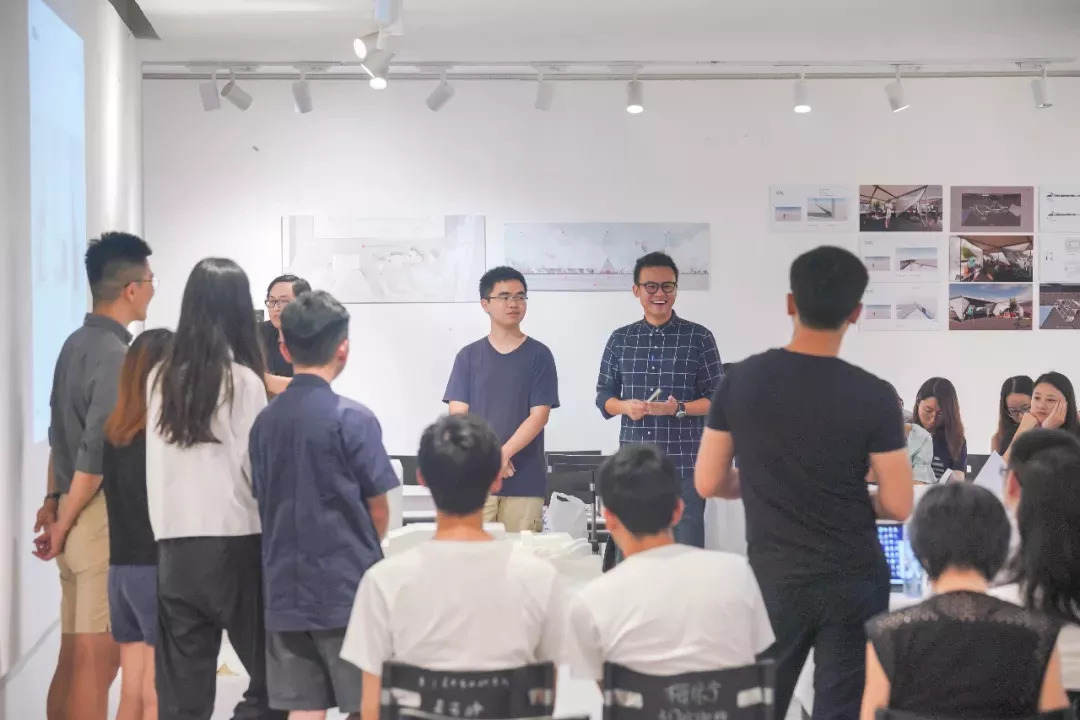
任务:端头形象展示、与PSA入口形象呼应、与其他部分共存
策略:结构·聚散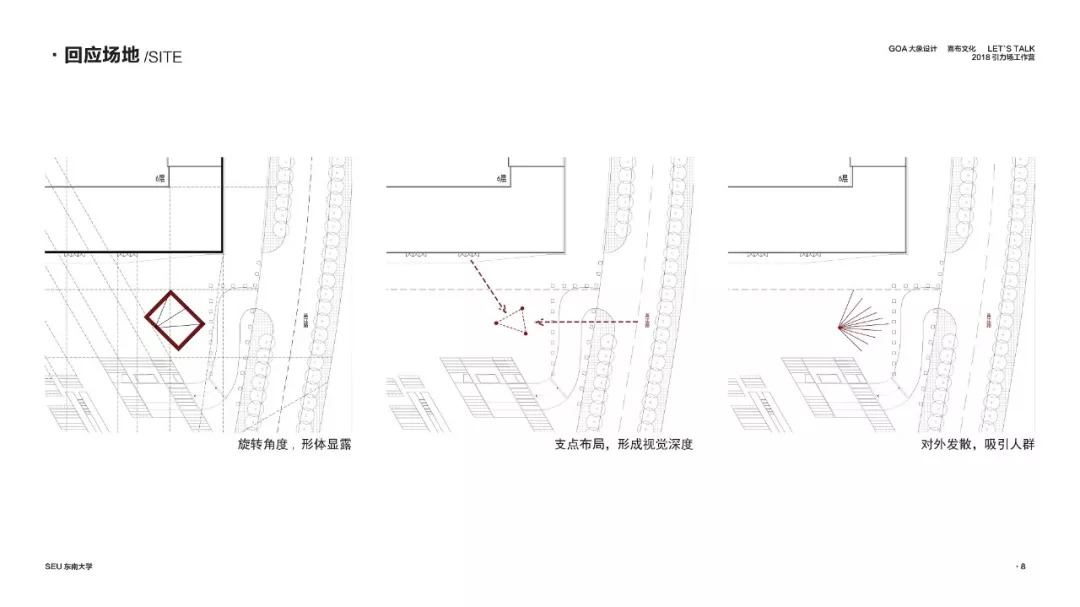
对使用者来说,结构向着城市发散(散),使人群聚集过来(聚);
从形式上来说,聚和散是结构在形式上的特征;
对设计者来说,结构设计贯穿各个阶段(聚),延伸至各个方面 (散)。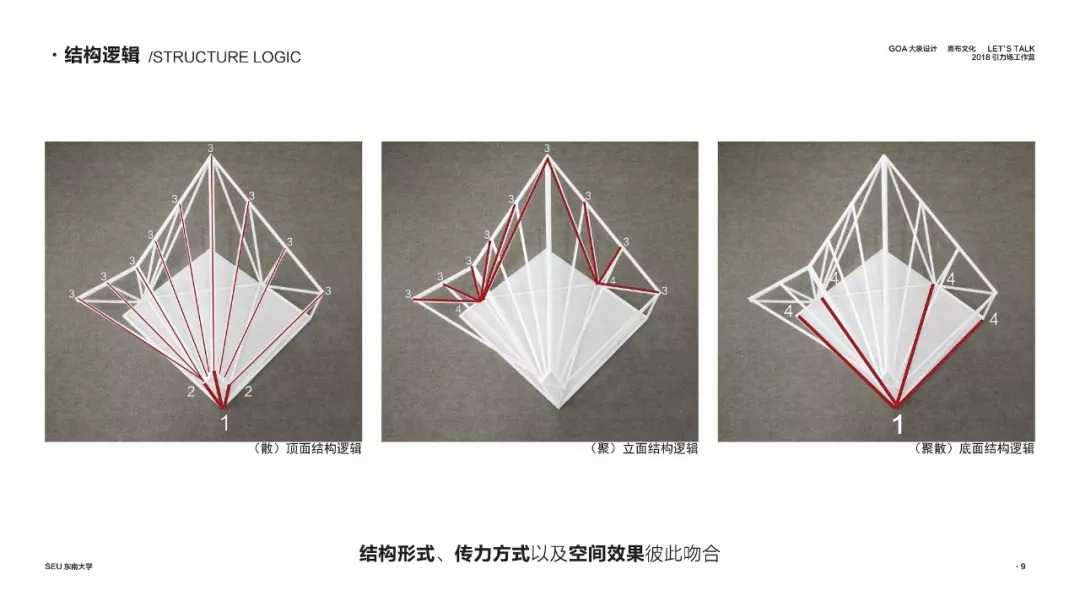
结构从顶面发散而后经立面在底面汇合,契合了设计的逻辑。结构方式,传力方式和空间效果彼此吻合,既符合形象主题,也符合功能主题。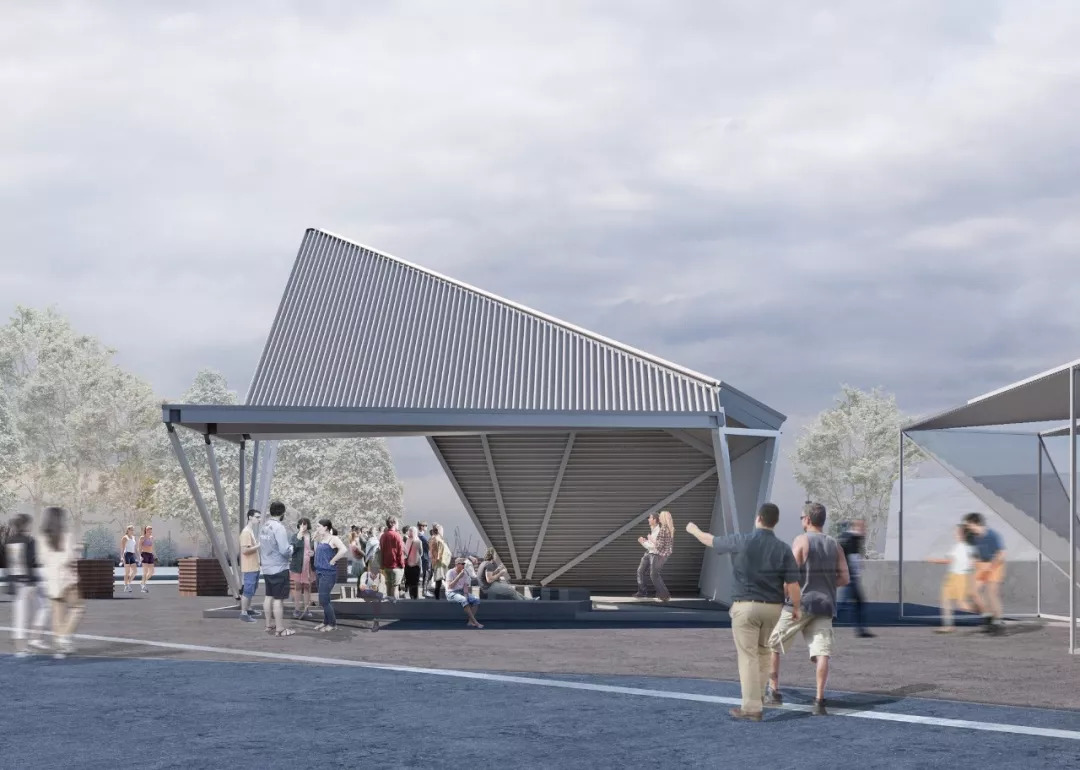
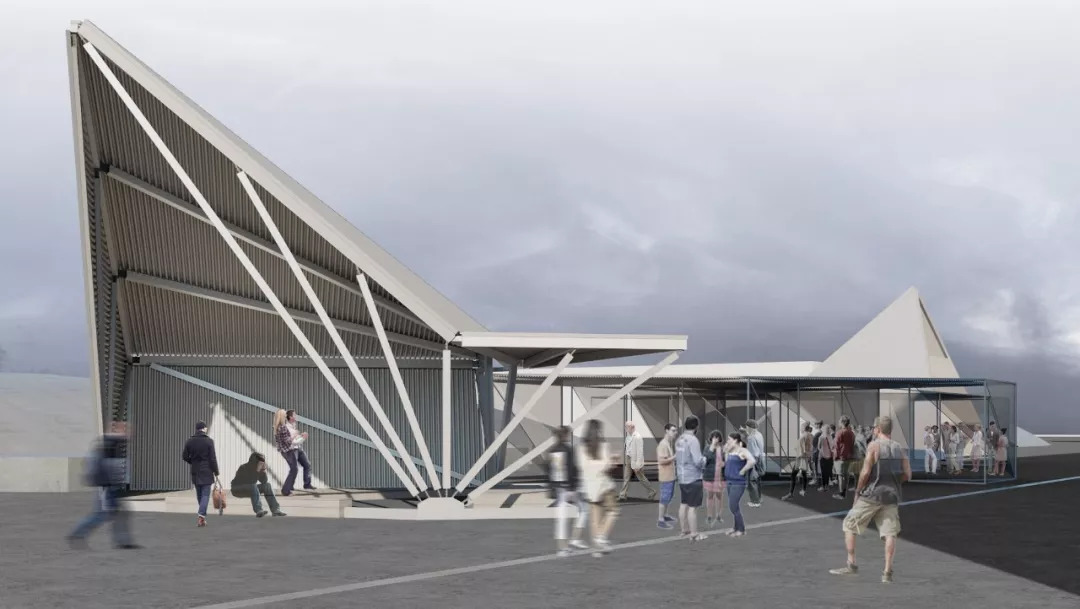
通过舞台面向街道,吸引人流进入,进而,内部活动的发生,如演讲、演出、秀场等方式,吸引人们参与进来,赋予其更加丰富的使用意义。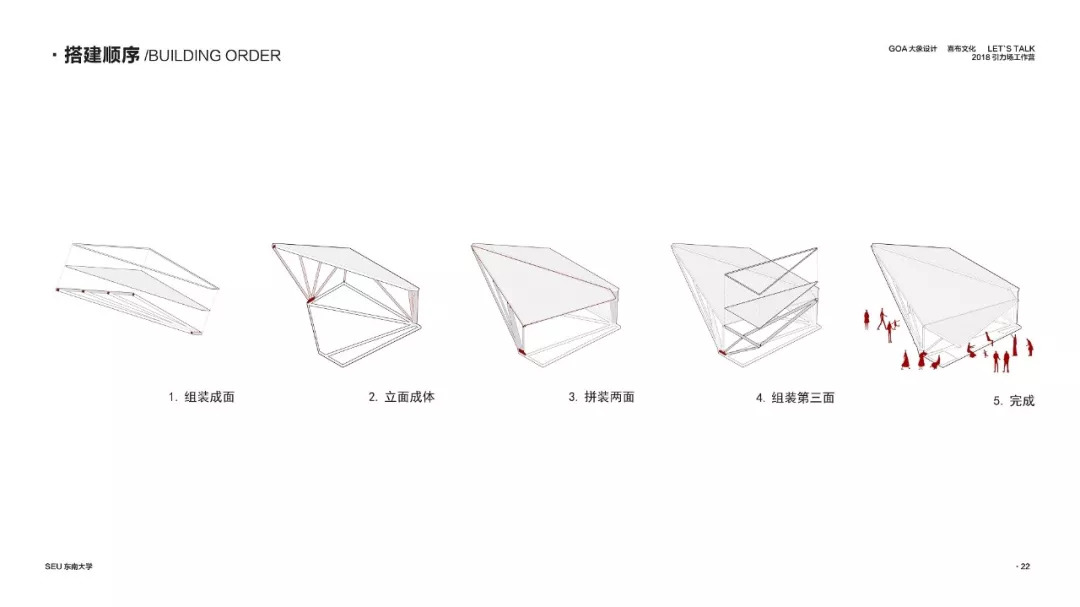
技术:钢结构搭建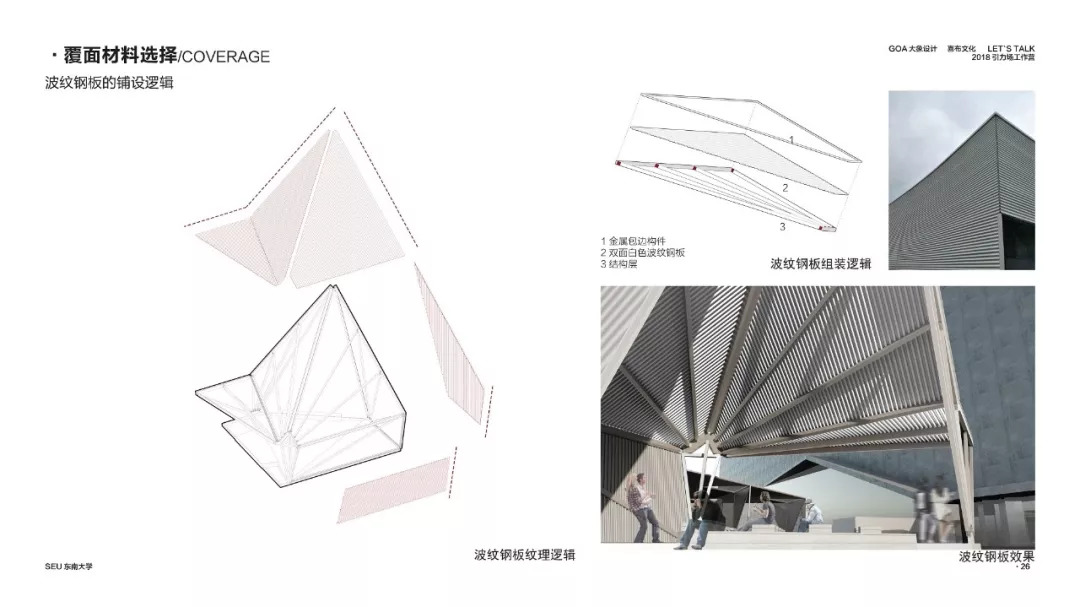
覆面材料选择波纹钢板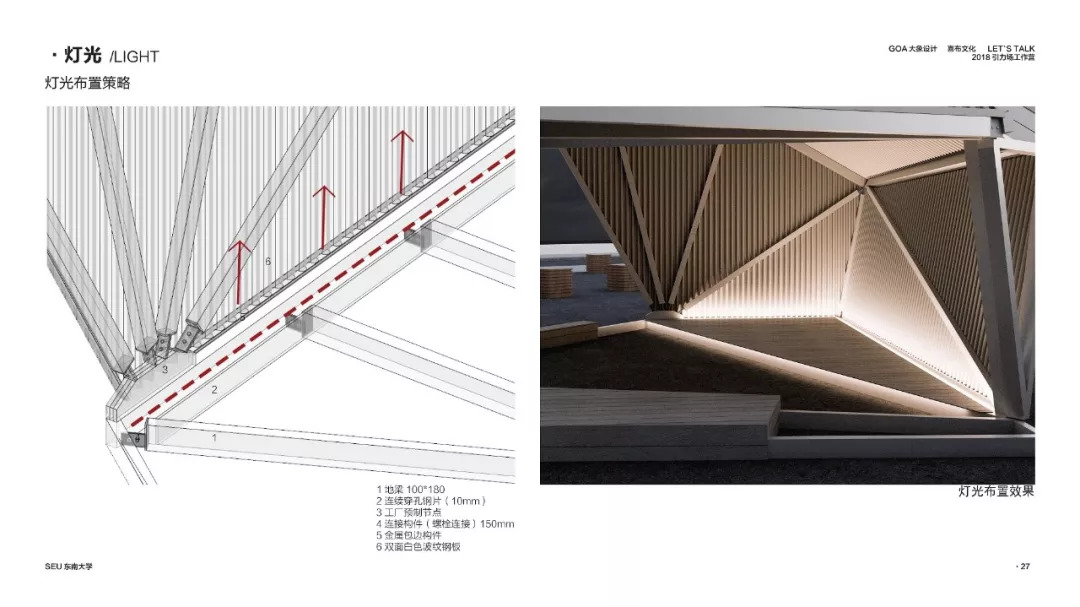
灯光布置,与波纹方向平行
小组二
>>> 穿云——趣场 <<<
虞思源、李嘉文
中国美术学院建筑艺术学院大四学生
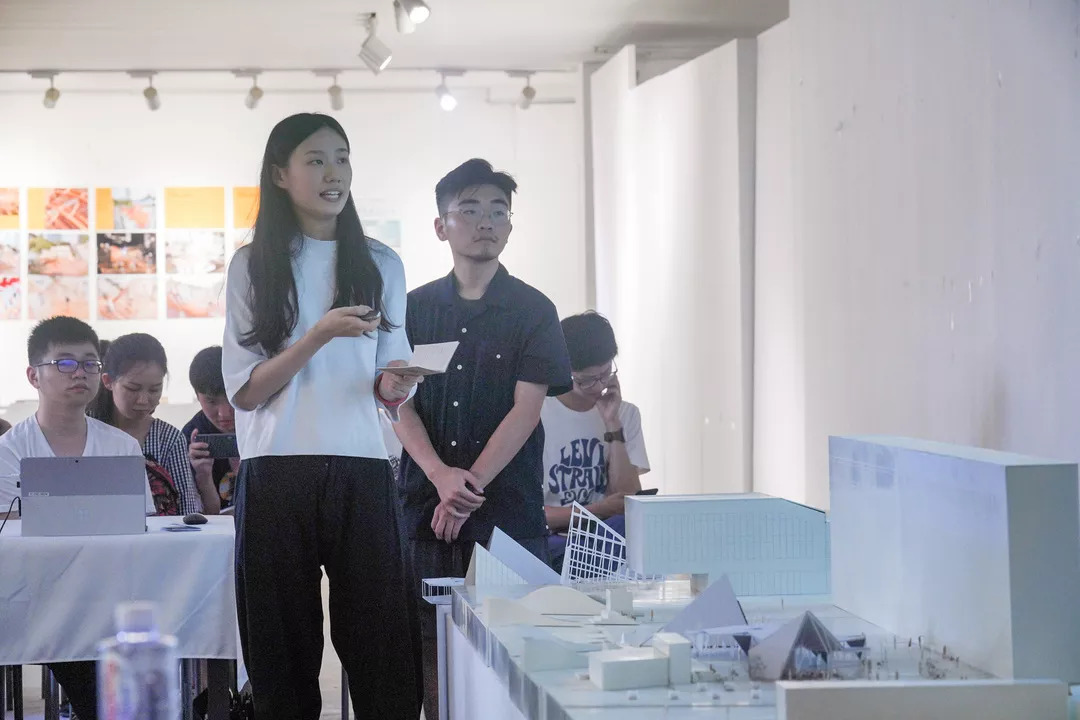
问题:场地过于空旷,白天这里几乎毫无活动发生,只有夜幕降临之时,才会有一些居民到这里活动。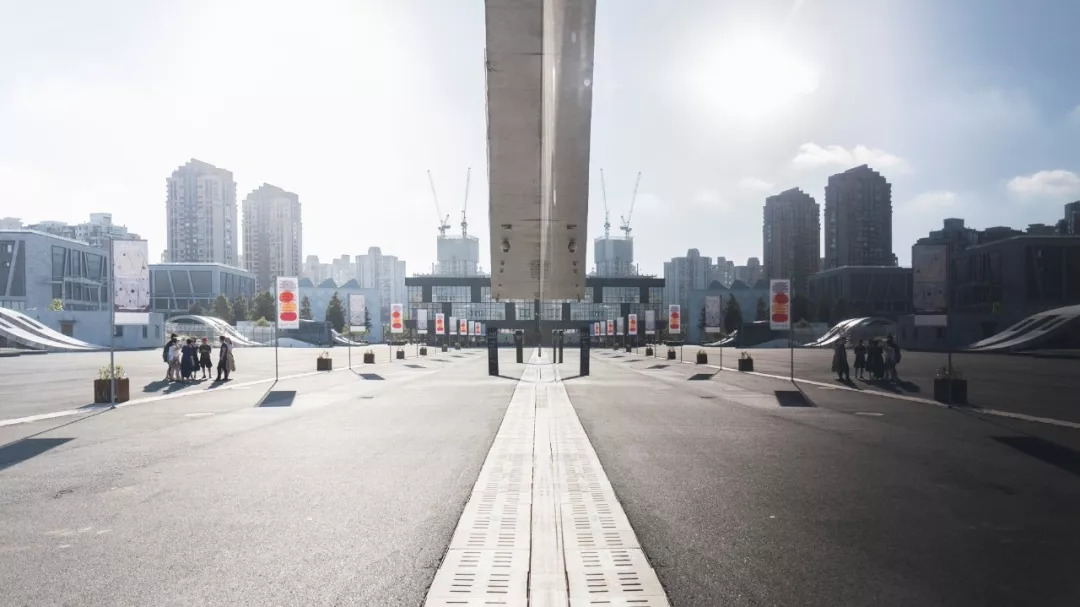
期望:整个广场可以全天候的利用起来,通过微更新重新焕发广场活力。
着手点:漂浮的云雾,人们在云雾中穿行,既躲避了烈日又其乐无穷。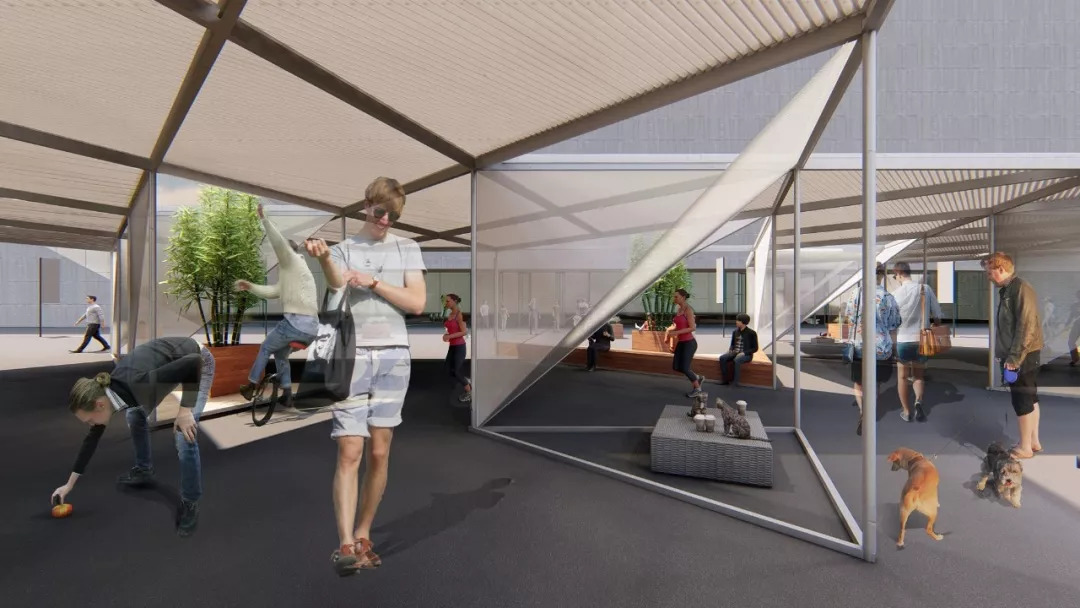
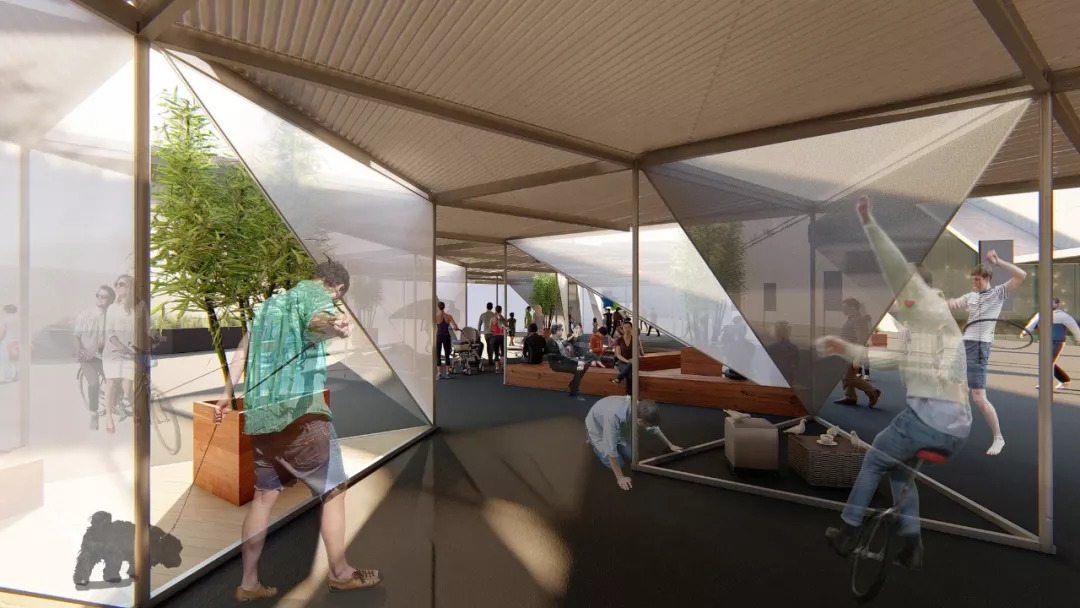
趣场是本次引力场活动中变动最大的,从刚开始的整个场地全面铺开,到后来的集中在场地前半部分的亭子,趣场成为了一个具有丰富界面的城市休憩亭。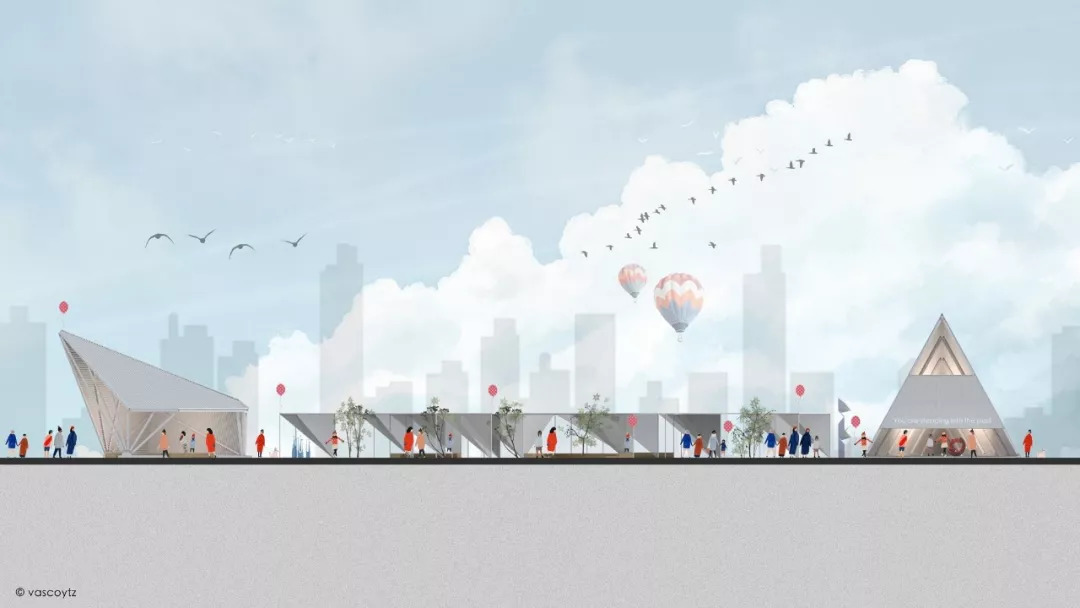
论点:一个具有丰富界面的城市休憩亭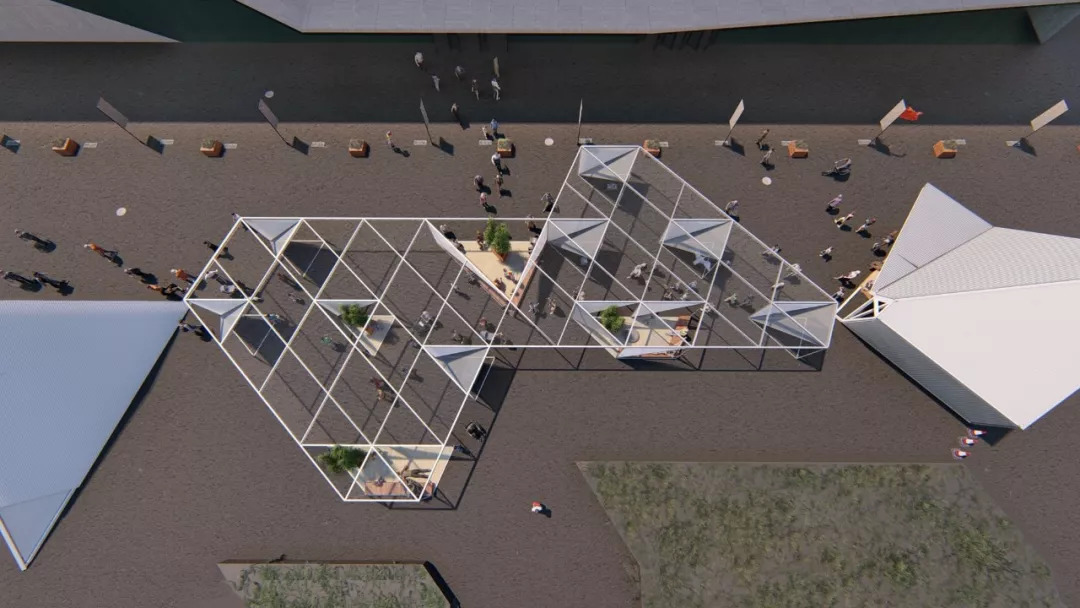
三角形板形成多层次的视觉进深,对外部呈现出开放的姿态,内部的多种活动也在等待着发生。 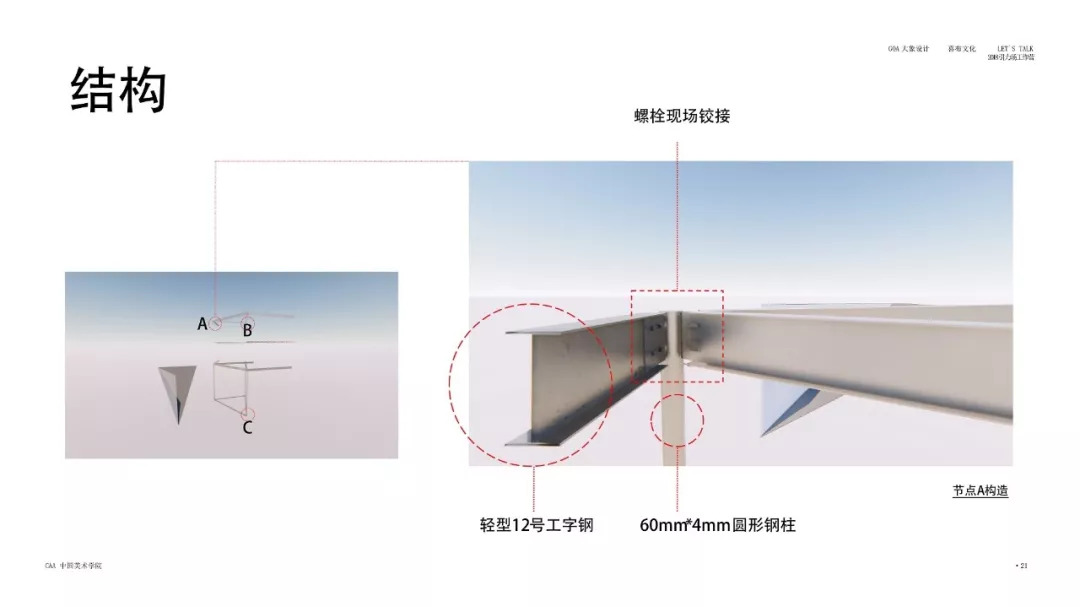
结构上,主要采用工字型钢与螺栓现场铰接。
小组三
>>> 回望——展场 <<<
杨天周、邓希帆
同济大学建筑与规划学院大四学生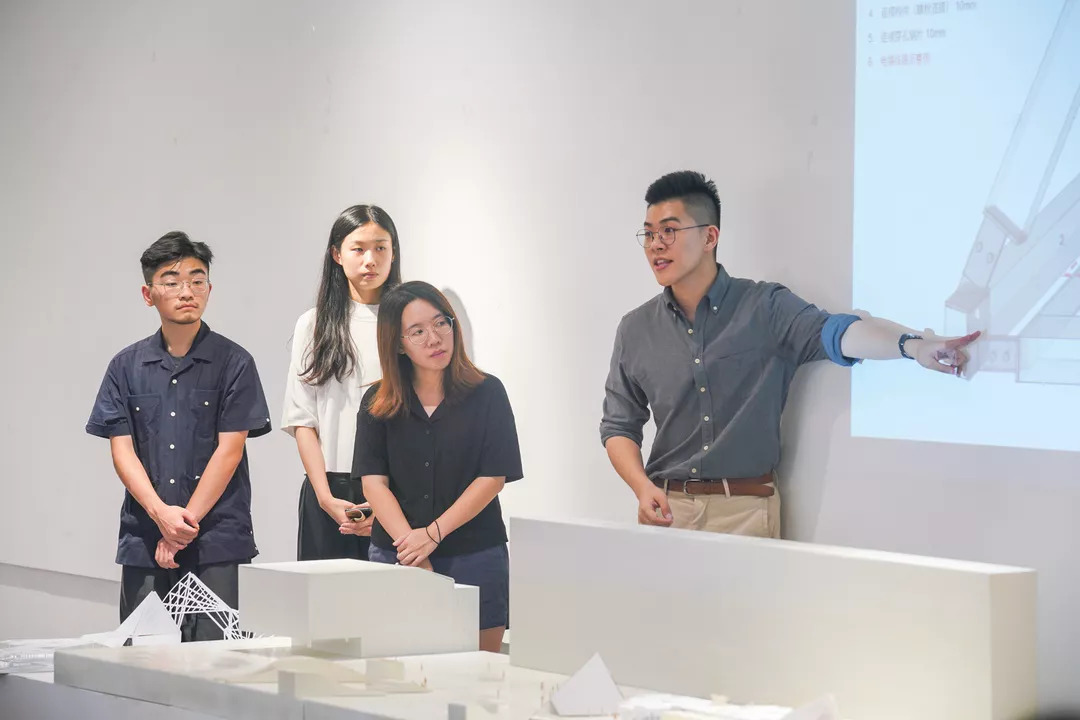
思考:从“展”本身入手考虑,是否可以让当代艺术馆本身就成为一个展览品。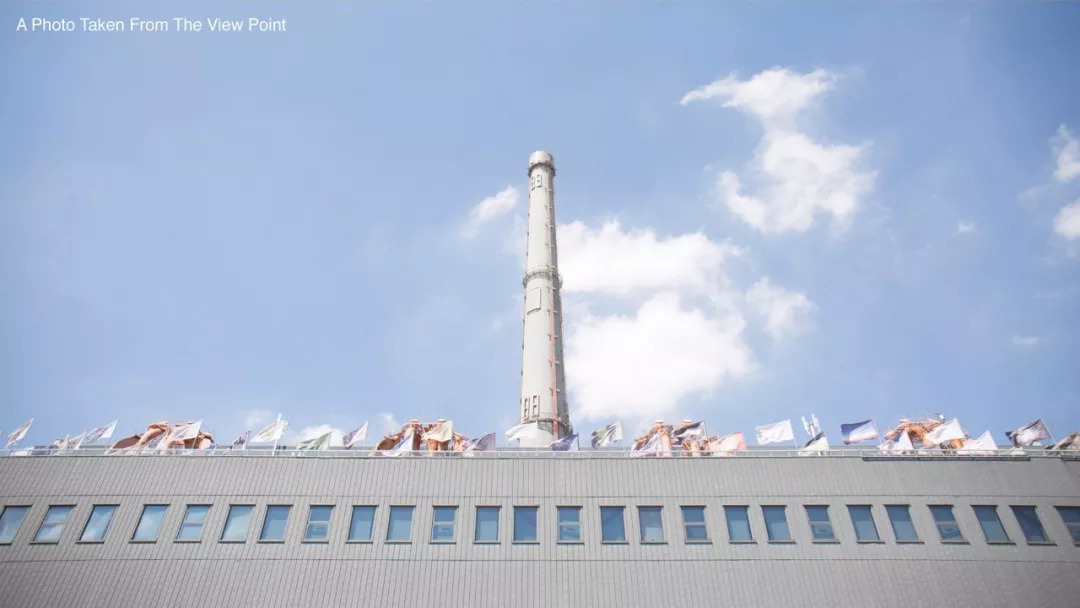
分析:烟囱作为工业时代的象征,在现在的“互联网时代”已经属于较为落后的一方,PSA改造了这些曾经以为应该推倒的建筑,赋予其新的意义,使人们重新认识到了这些建筑的价值。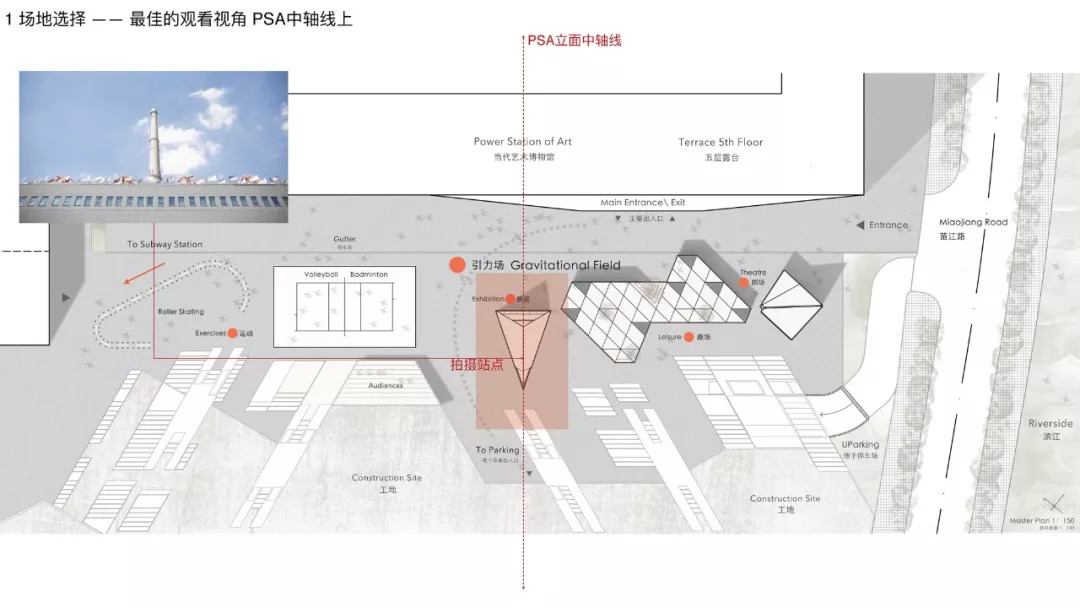
策略:把展场放在PSA的中轴线上,为最佳观看视角。
在体量上经过自由平面、方形平面和三角平面等多种方式的推敲,最后在材料、构造和结构的多方面考虑下确定下三角锥的体量形式,稳定感较强,且在剖面上的高度变化也能塑造不同的功能空间。
在入口的考虑上,从南侧进入流线组织较为方便,观看烟囱的视觉效果也更好。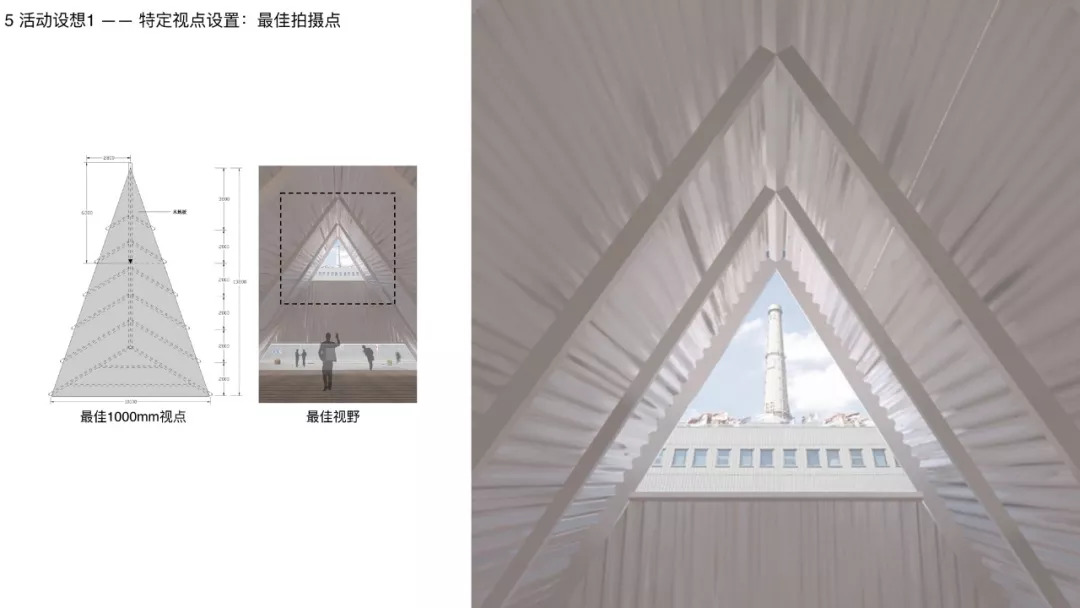
在展场内最佳拍摄点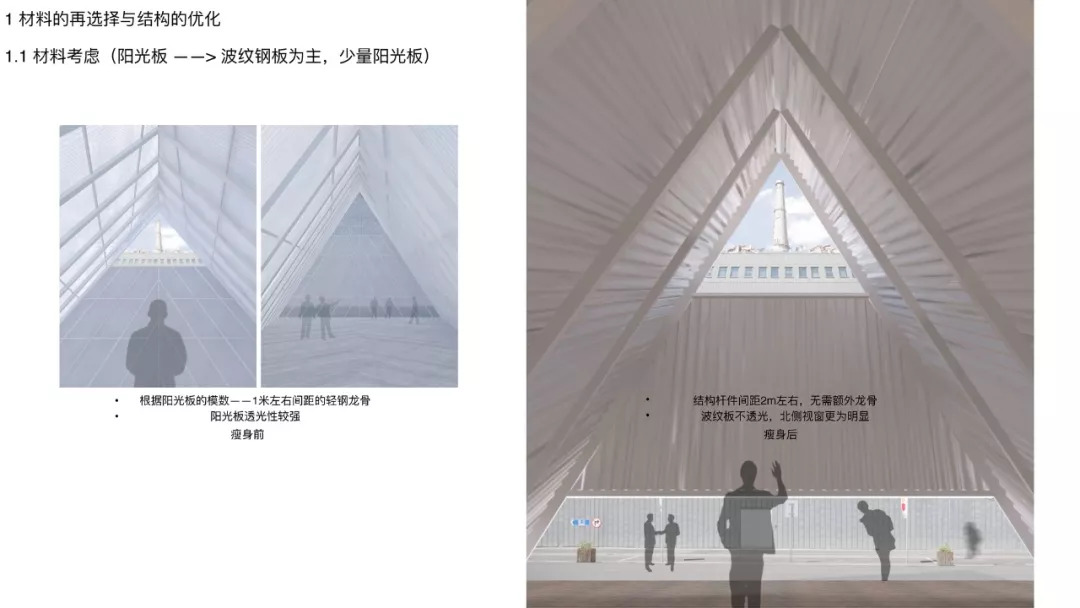
材料上,以波纹钢板为主,少量阳光板
节点设计上采用统一龙骨,连接杆件、铺装、灯带、插座统一考虑。
评图问答
>> 关于“总体协调” <<<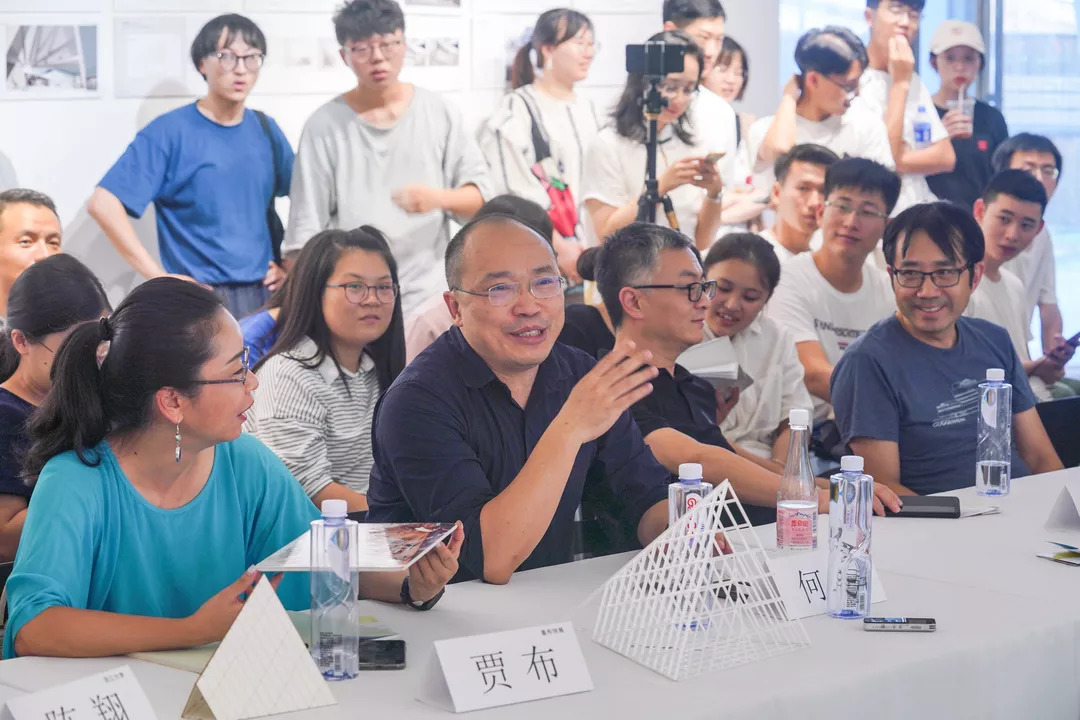
评委:你们在设计过程中是如何与甲方沟通的,清楚这个项目的甲方是谁么?
营员:这个项目的设计方是三校联合,我们的甲方也是三方联合体。我们在需求上要和负责艺术策展和展期活动的贾布老师配合,GOA的王彦老师提出了功能、预算、材料等要求,而戴春老师为我们解释了城市微更新的意义并为我们把握学术方向。我们每周一次的方案沟通会,设计团队和甲方团队都有非常充分的沟通。
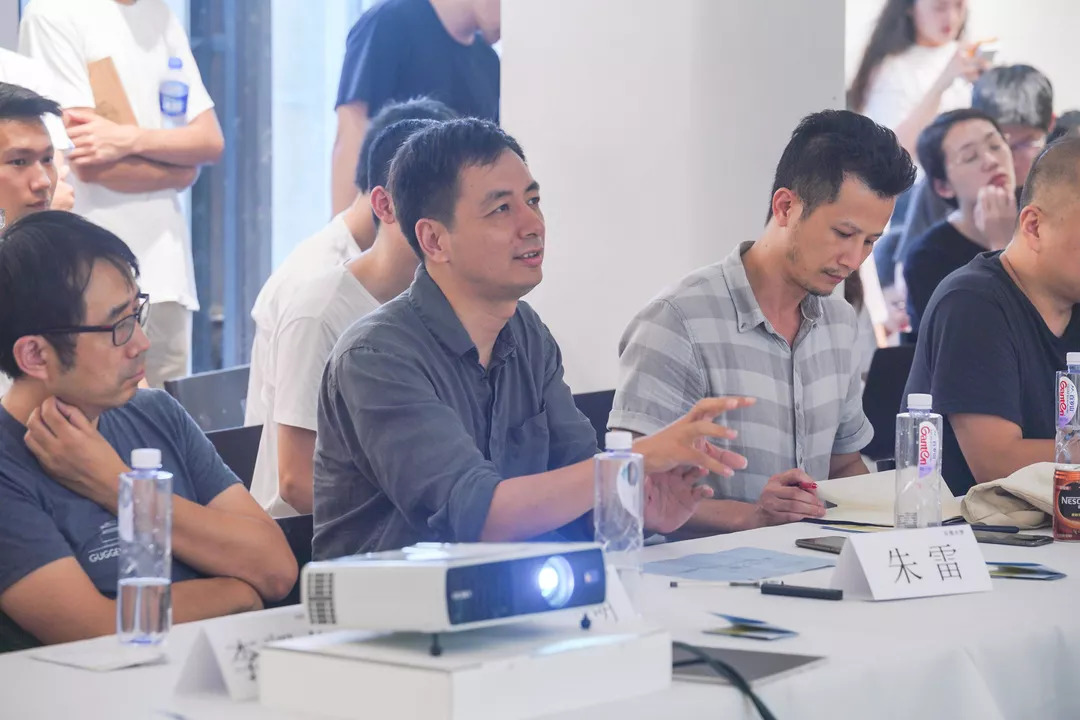
评委:规划是如何确定的?
营员:各组同学都做了一个规划方案,展场部分先定位整组建筑开始的部分,然后是面对街道的剧场和链接两者的趣场,这是共同工作的过程。总体布局的要求是拥抱入口,遮挡后面不太美观的界面,最终的建筑之间的角度,建筑和PSA的相对角度都是算出来的,是唯一解。
趣场拥抱入口,同时和街道形成一个开放的姿态。总体在建筑高度上有一个高低高的节奏考虑。剧场在高度上面有降低,让后面的展场能露出来。展场和剧场是两个相对独立的点,趣场一直扮演着和协调者的关系,趣场的难点是在协调和展场剧场的关系、和相邻场地建筑的关系的同时又要做得有趣。
趣场经历了最多的修改,从一开始的长向布置,占据整个展场,到慢慢缩减到现在的结果。这中间有很多原因,最主要的原因是大家达成共识,所谓的趣味空间不应该是让人一眼看透的空间、需要有丰富的层次,深度、多层次空间处理手法,现在的结果,长度能够达到沿街效果,宽度达到深度效果。整组建筑的每个部分做到了既能互相照应又有相对的独立性。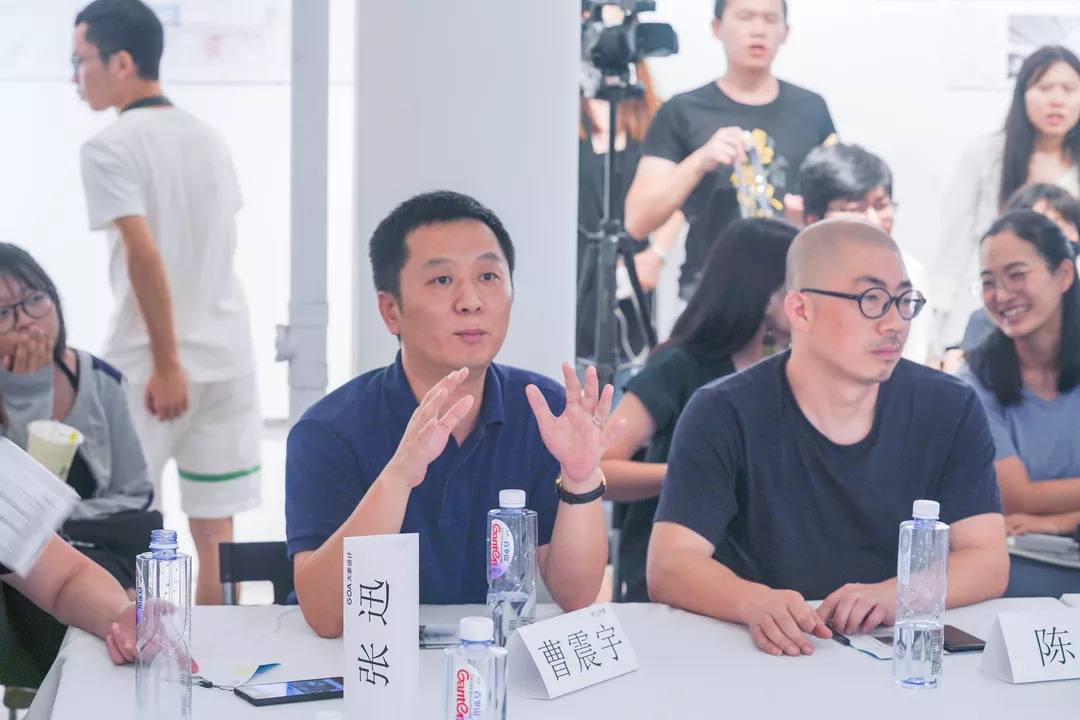
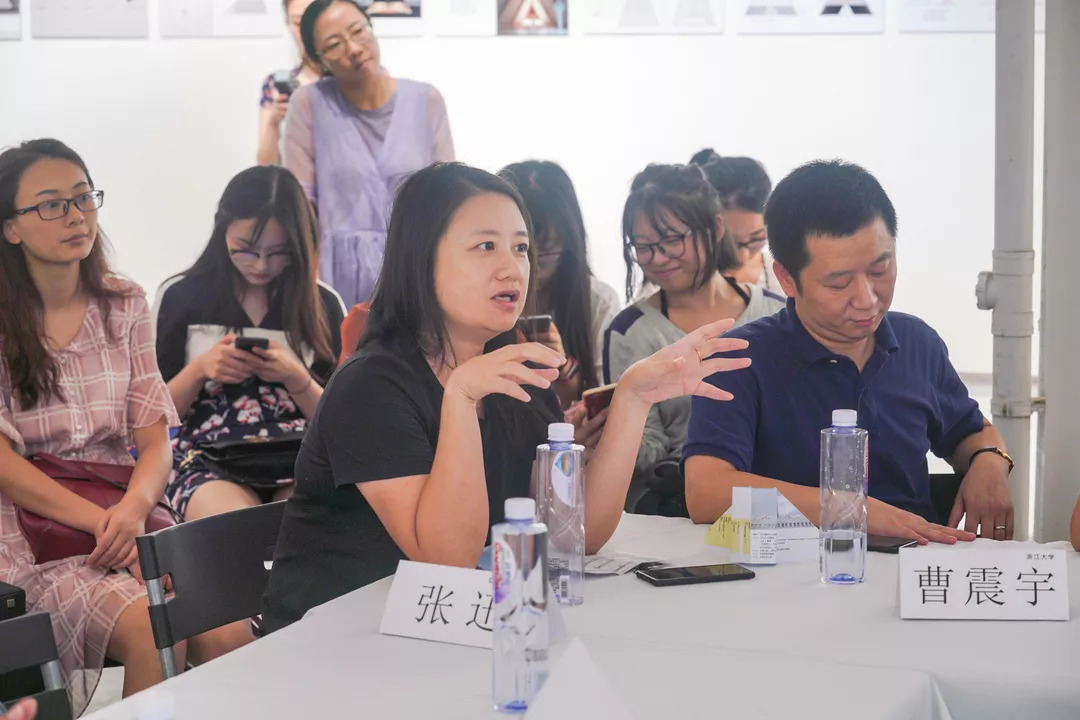
评委:在设计过程中有哪些外部协调内容?
营员:因为我们的场地紧贴着PSA,又将要在双年展期间开幕。所以我们对2018双年展主题做了一些研究。
2018双年展主题是“禹步”,这是中国古代道教仪式的步法,是一种徘徊于进退之间的神秘舞步。我们当时觉得一头雾水,但看到它对应的英文标题“Progress”才恍然大悟,觉得这届双年展可能是在探讨Progress(进步)和Regress(倒退)的辩证关系。那么我们想到如果我们在今天科技大发展的时代,选用非常廉价的材料但同时又创造出非常有品质的空间,也是我们对双年展主题的回应。
在具体的设计过程中与结构、造价、施工的协调是我们每天很重要的工作内容。
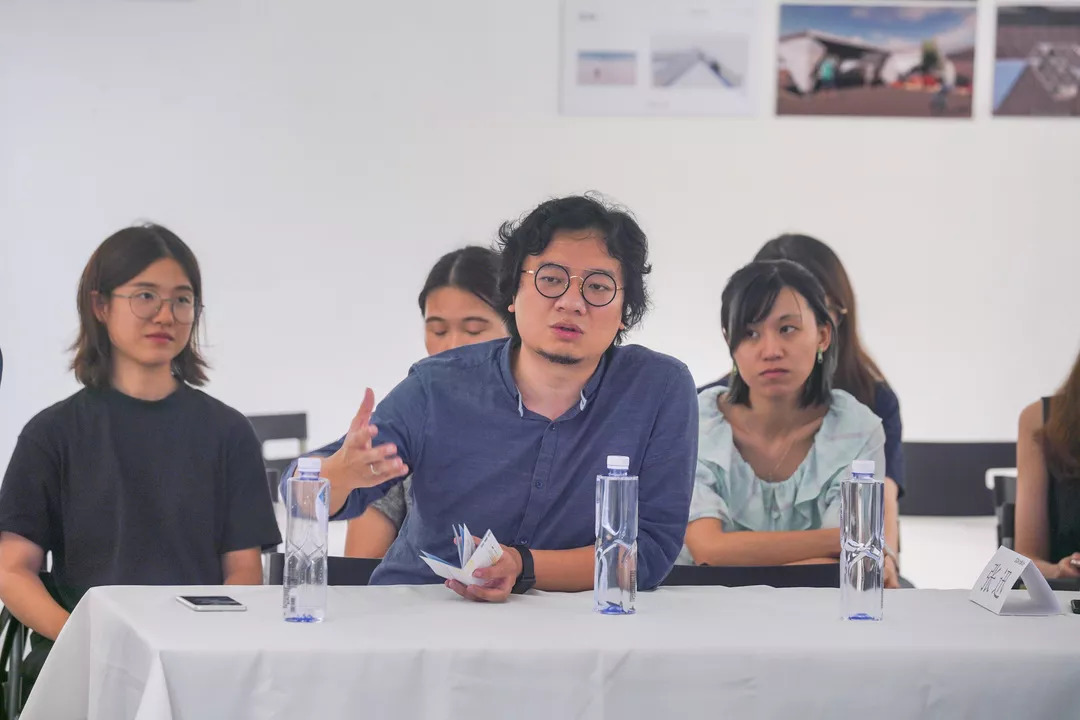
评委建议
甘昊:我认为微更新主要需要解决三个问题。第一,是微,如何以小见大。展场组同学把周围的环境特点融入到设计中去,是一种小中见大的方式;第二,是对环境的回应。如何在空间上回应周遭的使用需求,组织活动吸引人群,激发人和建筑互动的多种可能性; 第三,"更新"意味着要变得更好。微更新主要发生在城市当中,城市是当代人和社会的集合体,当代社会矛盾很多,社会结构的问题就需要考虑。另外,我们的这组建筑到底和双年展的关系在哪里?我们对当代艺术的贡献在哪里?在类型学上有没有突破?比如有没有可能为闪电展这种新型的展览方式创造一种新的建筑形式?
>>> 关于“材料” <<<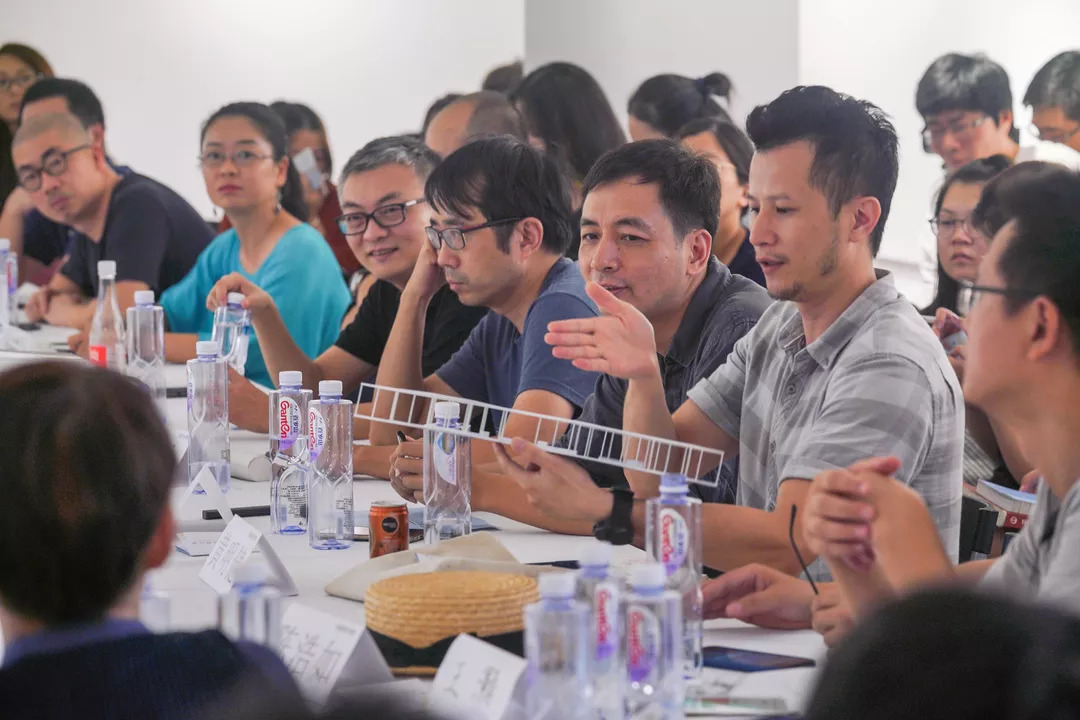
评委:为什么使用现在的材料?这组建筑物还考虑了移建的可能性,关于它的使用寿命做了哪些考虑?
营员:考虑到后期移建的可能性,轻钢结构和螺栓的结合方式是我们的设计要求之一。我们在设计过程中也研究了杜邦纸作为隔断材料,但和材料厂家联络测试使用寿命没能达到相对长期的使用要求。我们原先想使用阳光板作为屋面的主要材料,希望能创造出不一样的触感和氛围光线。最终选用波形钢板作为主要屋面材料,一是考虑了排水的便捷,二是由于波形板的构造特点能为屋面省去更多钢梁,能使空间更简洁也节约成本。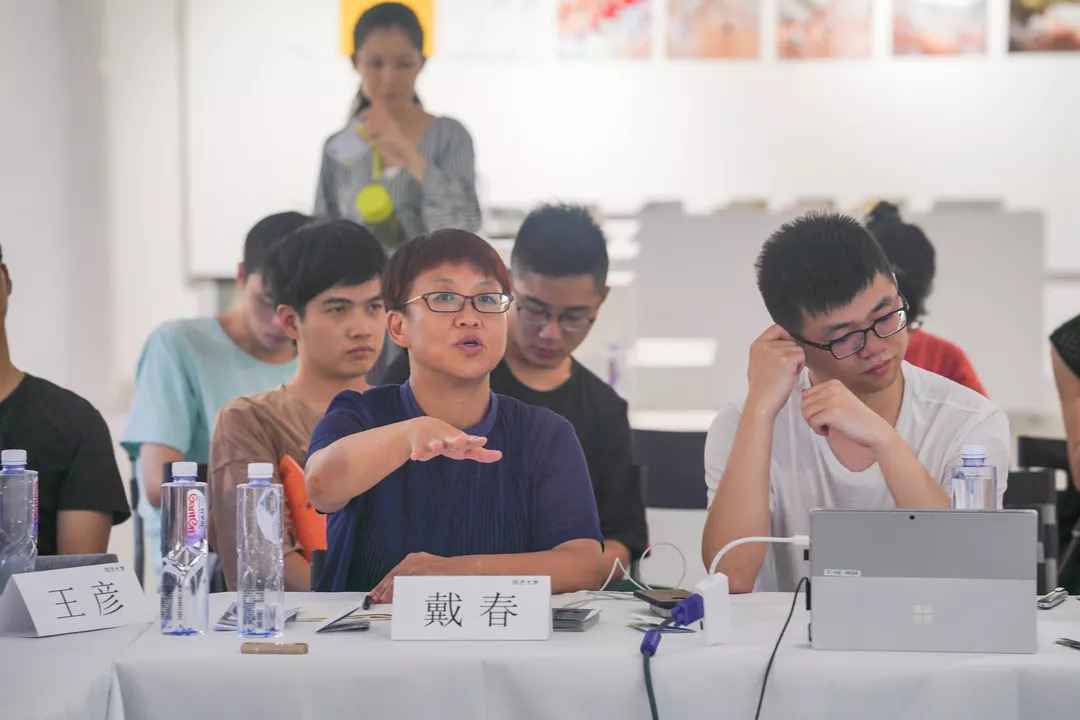
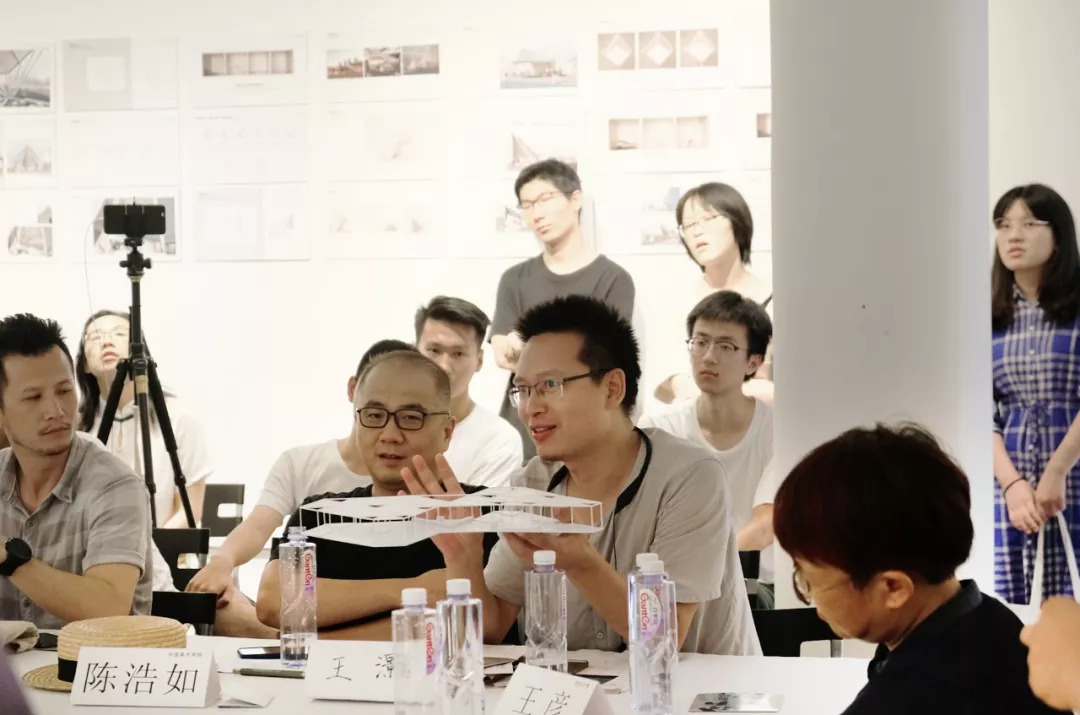
评委建议
童明:是否可以考虑以选用的材料和场地有所呼应?比如加入一些本地特有的旧材料。
王灏:我们需要思考一个建筑师设计的轻钢结构,和做轻钢搭建的熟练工的成果有哪些不同?我们是否可以有更多的创新?趣园的支撑是一个杆件的支撑是否还是可以有三角形的构建成为一种空间语言,是值得推敲的。
陈浩如:轻钢结构也有很多种,圆管、方管、片等,单一的材料形式可能会减弱建筑语言。蛇形画廊每年都有建筑师艺术家参与的搭建,用各种方式思考形式、材料、艺术品空间的统一性。我建议是否可以在你们现有的材料之外再加一种材料形式,比如说再生材料等,让标准化的东西多一些变化,学生作品还是很可能成为大师作品的。面对造价和材料的限制,是否还可以有另外一种设计方式?比如说100根钢材,我可以有哪些组合方式。
>>> 关于“技术” <<<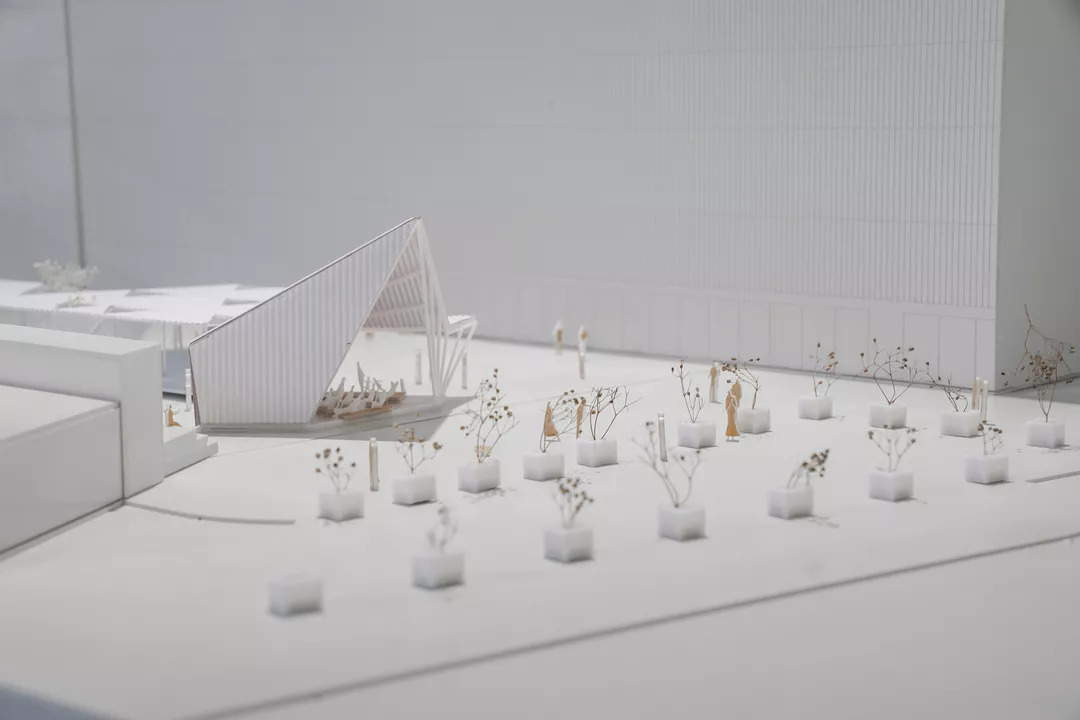
评委:建筑的稳定性如何考虑?
营员:目前我们都是通过压重的方式解决稳定性问题。我们和结构工程师沟通,确定了在地梁上压重的点,会和家具座椅结合。
评委:展厅眩光问题是如何考虑的?
营员:由于本次参展作品都不是传统意义上展品,以装置和行为艺术为主,所以我们认为不需要象传统展览空间那样严格控制非常柔和的光线,灯光布置更多从展场氛围考虑。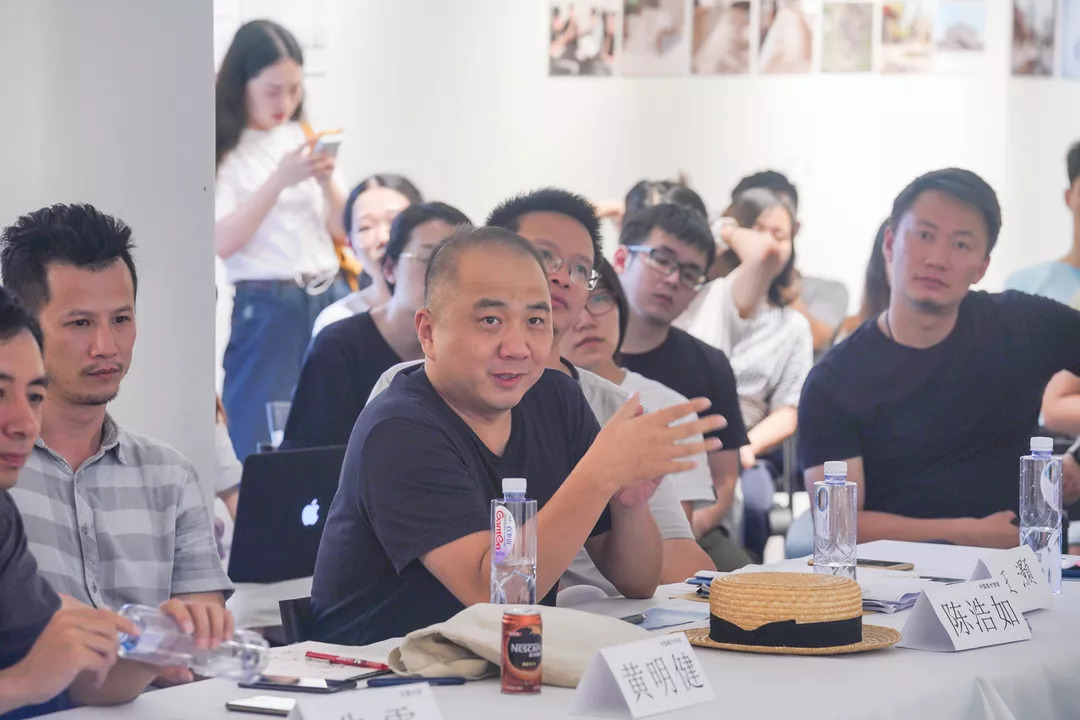
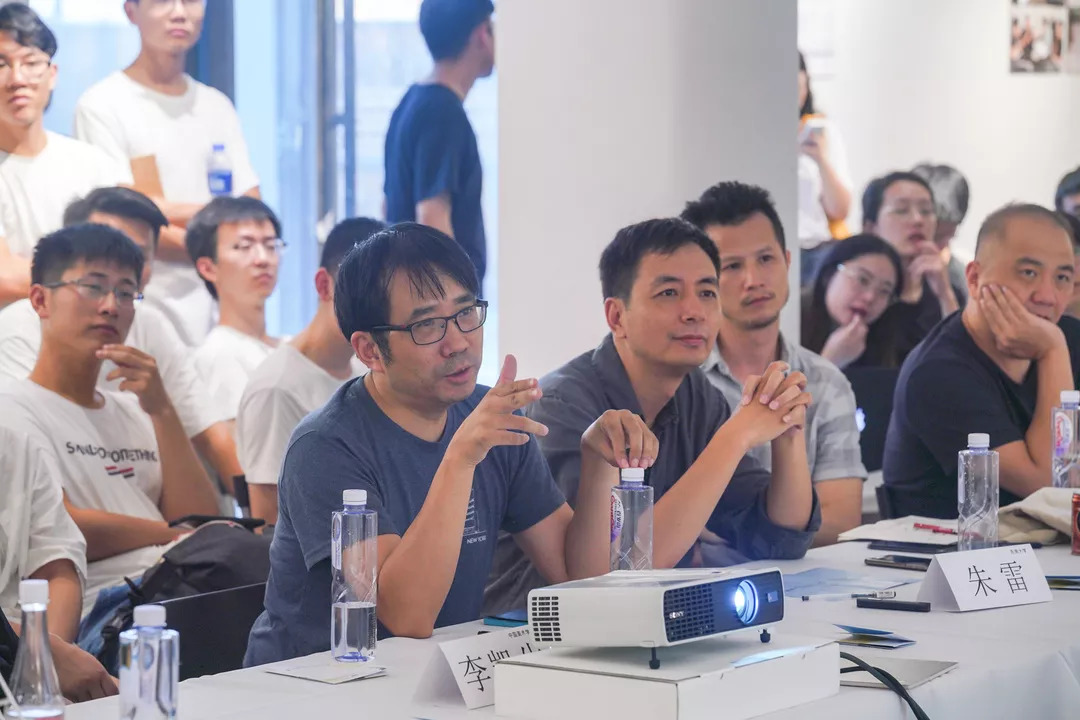
评委建议
甘昊:11月的上海,尤其在江边需要重点考虑风和雨的问题。压重的方式除了沙袋,也可以使用水,更加灵活方便。
李凯生:波形钢板的排水还需要进一步的完善,自由排水仍需要一定的组织,尤其平屋面排水的处理、接缝的处理都需要进一步深化设计。展厅虽然针对的不是传统展品,但仍需考虑日常的照明系统。
童明:剧场除了造型的考虑,需要对表演场景进行进一步细致研究。现在的灯光仅仅考虑了建筑形体的照明,将来会有什么样的表演?会需要什么样的灯光氛围?这些问题都需要考虑。你们的作品不仅仅是艺术品更是一个可以使用的建筑。
讲座嘉宾
童 明
同济大学建筑与城规学院教授、博士生导师
TM STUDIO建筑事务所主持建筑师
研讨嘉宾
(按姓氏笔画排序)
王 彦
同济大学建筑与城规学院客座教授
GOA大象设计总建筑师
王 灏
润·建筑工作室主持建筑师
任教于中国美术学院建筑艺术学院
甘 昊
东南大学建筑学院特聘研究员
木土工作室Atelier MUTO创始人
朱 雷
东南大学建筑学院建筑系主任
阮 昊
零壹城市建筑事务所创始人、主持建筑师
任教于中国美术学院建筑艺术学院
李凯生
中国美术学院建筑艺术学院副院长、
环境艺术系系主任
青道房设计工作室主持建筑师
何 兼
中国美术学院建筑艺术学院客座教授
GOA大象设计执行总裁、总建筑师
张 迅
GOA大象设计总建筑师
陈浩如
中国美术学院建筑艺术学院副教授
山上建筑事务所主持设计师
陈 翔
浙江大学建筑工程学院建筑系副主任
贾 布
喜布特展创始人
黄明健
设计聚合(DESIGN HUB)创始人、主持建筑师
任教于中国美术学院建筑艺术学院
曹震宇
任教于浙江大学建筑工程学院建筑系
主持人
戴 春
Let`s talk创始人
城市微空间复兴计划发起人
同济大学《时代建筑》杂志运营总监、责任编辑
2017上海城市空间艺术季联合策展人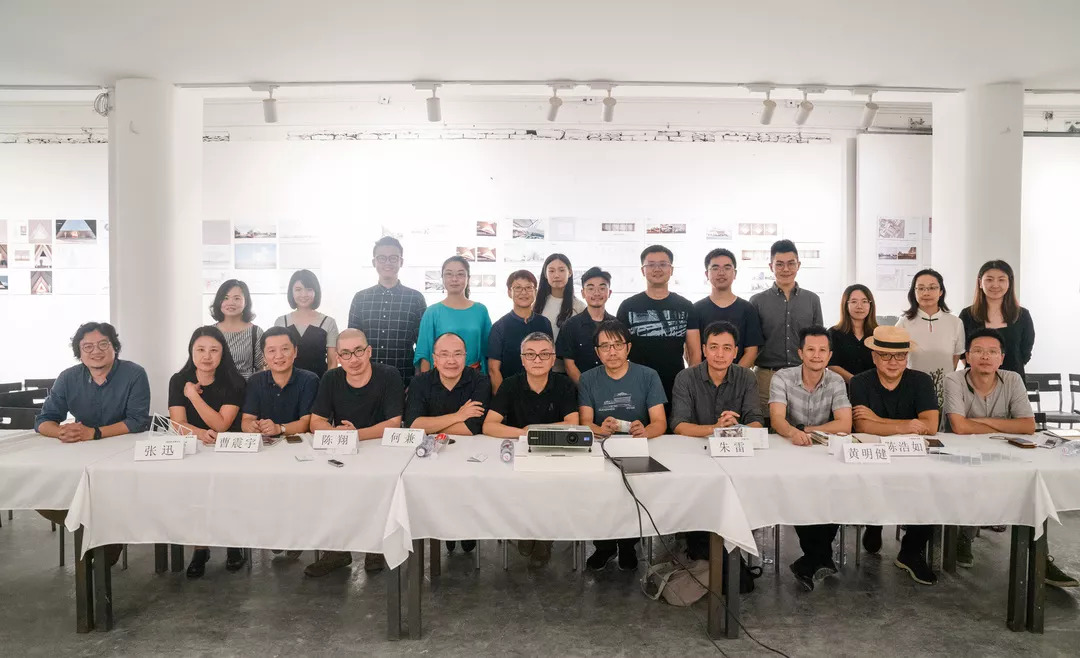
On the afternoon of September 6, 2018, a proposal evaluation meeting of “Gravitational Field 2018 – Work Camp of the Urban Micro Space Revival Plan”, organized by GOA, Let’s Talk and XiBu, was held at No.12 Building of China Academy of Art. At the meeting, six contestants from Tongji University, Southeast University and China Academy of Art presented their proposals for the competition, and had an exciting discussion with 15 judges present. 




An Overview of Gravitational Field
Urban Micro Space Revival Plan
Gravitational Field
2018 Work Camp
“Gravitational Field – A Link between the Art of Architecture and the Public Cultural Life” is an event launched by GOA. So far, there have been two successful editions of Gravitational Field. GOA hopes to identify and cultivate promising young architects through the research & construction of specific public space revival projects, and provide them with good opportunities to demonstrate creativity. In the meanwhile, each project completed will become a “gravitational field in the city”, providing spaces for community activities, artistic performances and parent-child games to spice up the vim and vigor of city blocks.
In 2018, GOA partnered with Let’s Talk to launch the 2018 Gravitational Field Work Camp to sustain people’s attention to urban space revival. The number of judges invited to the event is even more than twice as big as that of participants, as the aim is to ensure that the finalized works can withstand testing and be better presented to the public. In the meanwhile, it’s also an interesting experiment to work with universities to expose students to real-life setup processes. During the design and setup process, GOA and many well-known architects will mentor the students. The final installation will be set up and shown to the public at the front square of the Power Station of Art (PSA) in early November, and a series of academic activities and public events will be organized too.


Proposal Evaluation Meeting of “Gravitational Field 2018 – Work Camp of the Urban Micro Space Revival Plan”
Gravitational Field 2018
Work Camp of the Urban Micro Space Revival Plan
A Review of the Proposal Evaluation Meeting
An Introduction to the Activities and Needs of Gravitational Field
Jia Bu
Founder of XiBu
Gravitational Field always highlights two key elements, artistic installations and field activities. Any work of public art should be able to comply with the aesthetic taste of the public and have functional value.
-Site Upgrading: This year’s venue is located at the front square before the entrance of the Power Station of Art (PSA), with an area of 2,300 square meters.
- Requirements for “Exhibition”: This year, we will introduce a new form of exhibition called “X Flash”, which means that we will arrange different exhibitions for different days. Each exhibition will start setup at 10:00 a.m., and be demolished at 19:00 p.m.. Any materials used are not allowed to be left at the site over the night, so artists are required to use light-weight materials. The space of Gravitational Field must allow for the exhibition setup and demolishment needs, and mostly, natural lighting should be utilized for exhibition purposes.
- Requirements for “Theatre”: Rests, activities and small-sized
- On November 10, the PSA will organize Shanghai Biennale, an exhibition that is highly influential worldwide. This is sure to attract large numbers of visitors to our Gravitational Field.
- Analysis of Design Conditions
- Wang Yan
- Visiting Professor at the College of Architecture & Urban Planning of Tongji University
- Chief Architect of GOA
The Power Station of Art (PSA) is the most influential contemporary art museum in Shanghai. However, there has never been any event organized at its front square, the land management and use right of which lies with the nearly Urban Best Practice Area (UBPA), which is now an office area, rather than the PSA. During the daytime, you can rarely see office people doing any activity here. In the evening, some local residents will come here for leisure and relaxation. However, as there are no facilities or amenities, most of the traffic is not planned or organized in advance. This area is in the vicinity of the Huangpu River. Last year, Shanghai completed the connection project along the banks of the Huangpu River. Since then, Shanghai citizens have started to jog along the river. There are a lot of joggers in the evening, but they seldom come to this space for activities.


Presentations by Camp Participants


The project highlights connection with local communities. It exploits the advantages of the space to provide local communities with opportunities for more activities and interactions and create a unique and pleasant spatial experience. The project is scheduled to be launched on November 11 to inject powerful vitality into the area. 6 students from Southeast University, Tongji University and China Academy of Art, under the mentoring from architecture, structure, construction and material experts, are working hard to complete the project.
Team 1
>>> Come and Go - Theatre <<<
Zhang Xu and Qiao Runze
Seniors from the School of Architecture of Southeast University
Tasks: Image display, ensuring a match with the entrance of the PSA and harmony with other parts of the project
Strategy: To use a proper structure to emphasize the concept of “Come and Go”
For users, the structure extends outwards to other parts of the city (“Go”), and attracts people to gather (“Come”); thus, “Come” and “Go” characterize the form of the structure;
For designers, the structural design permeates and combines all phases (“Come”), and extends outwards to all aspects (“Go”).
The structure features a top with dispersive arms that are combined at the bottom, echoing with the logic of the design. It presents an interesting form of force transmission and creates a unique spatial experience, well fitting in with the image theme and the functionality purpose. 

As the stage faces the street, it can attract people to come and have a look. Then, the activities going on, such as speeches, performances or shows, can further engage people. In this way, the structure realizes a rich variety of service purposes. 
Technique: Setup of a steel structure
Corrugated steel plates are chosen for the coverage
The lighting is parallel to the direction of the corrugated steel plates
Team 2
>>>Walking through the Clouds - Leisure<<<
Yu Siyuan and Li Jiawen
Seniors from the School of Architecture of China Academy of Art
Problem: The site is empty and spacious, with almost no activity going on during the daytime. Only a few local residents come here for relaxation in the evening.
Expectation: Through the micro space revival project, it’s hoped that the square can be utilized and become lively during the daytime.
Idea: To create “floating clouds” so that people can have fun walking through them while sheltered from the scorching sun.


The “Leisure” section underwent the biggest change during the design period of Gravitational Field. From the initial extension of the structure over the whole site to the later focus on the pavilion in the front of the square. “Leisure” is now designed as an appealing place for leisure and relaxation with interesting interfaces for interaction. 
Conclusion: An appealing place for relaxation and leisure with interesting interfaces for interaction
Triangular boards create varied visual effects, while enabling the whole structure to look open and inviting from the outsides. Inside, it builds up people’s expectations for activities. 
Structurally, I-shaped steel pieces and bolts are hinged.
Team 3
>>>Review - Exhibition<<<
Yang Tianzhou and Deng Xifan
Seniors from the College of Architecture and Urban Planning of Tongji University
Thinking: From the perspective of “Exhibition”, is it possible to make the popular art museum an attractive exhibit in itself?
Analysis: The chimney is a symbol of the Industrial Age. Now, it looks obsolete in the Internet Age. Instead of demolishing it, the Power Station of Art (PSA) transformed it and gave it new meaning, purpose and value. 
Strategy: To place “Exhibition” along the central axis of the PSA for the best viewing angle.
After the evaluation of different forms, including freely-shaped planes, square planes and triangular planes, it’s finally decided that a triangular cone should be adopted after considering factors such as materials, construction and structuring. It’s because a triangular cone can ensure stability and allow the creation of different functional spaces based on height changes. 
It’s decided to locate the entrance at the southern side, as it ensures greater convenience to enter the structure and allows a better view of the chimney.
The Best Photo-Taking Point inside “Exhibition”
In addition to the use of corrugated steel plates, a small number of polycarbonate hollow sheets are used.
Keels of the same specifications are used, and connecting rods, paving, LED strips, and sockets are also carefully designed to ensure consistency.
Q & A Session for Proposal Evaluation
>>About “Overall Coordination”<<<
Judge: How do you communicate with the Employer? Do you have a clear idea who the Employer is?
Participants: Students responsible for project design are from three universities, and our Employer is a three-party consortium. We need to coordinate with Ms. Jia Bu, who is in charge of artistic exhibitions and other related activities, to ensure alignment. We also need to work with Mr. Wang Yan from GOA to meet his requirements about functionality, budget and materials. Besides, Dai Chun explained the meaning of the Urban Micro Space Revival Plan to help us identify the focus. We have weekly meetings to discuss our designs, so there’s sufficient communication between the design team and the Employer. 
Judge: How did you finalize your proposals?
Participant: Each team developed a proposal. The proposal for “Exhibition” was first finalized, because it’s where the whole set of structures starts. Then, it’s the “Theatre” section facing the street, and the “Leisure” section connecting the other two parts. This involved cooperation among different teams. Overall, we’re required to ensure integration with the entrance and conceal the less aesthetically pleasing parts. We worked out the best angles of the construction, and the best relative angle of the building and the PSA.
“Leisure” leads to the entrance while extending out to face the street. The overall design highlights a change in heights. The two ends are high, while the middle is low. “Theatre” is relatively low in height, allowing visibility of “Exhibition. “Exhibition” and “Theatre” are two independent points, with “Leisure” connecting and coordinating them. The challenge facing “Leisure” was how to balance the relations with “Exhibition” and “Theatre” and with neighboring constructions while ensuring a fun experience.
The proposal for “Leisure” underwent the most revisions. Initially, we wanted to stretch the structure along the whole square. Later, we reduced its length to what it is now. We did this for a lot of reasons. The most important reason is that we reached a consensus. We agreed that “Leisure” should have interesting dimensions, meanings and depths instead of offering a dull structure that can be easily interpreted. Now, the finalized design ensures that “Leisure” is long enough to run along the street and wide enough to have depths we want. Each part of the construction is independent while echoing and interacting with one another.


Judge: Was there any other factor you needed to coordinate during the design process?
Participants: Our venue is closely adjacent to the PSA, and the project is scheduled to be open to the public during the period of Shanghai Biennale. Therefore, we did some homework about the theme of “Shanghai Biennale 2018”.
The theme of Shanghai Biennale 2018 is “Proregress”, which refers to a form of movement used in the rituals of Taoism in ancient China. More specifically, it’s a mysterious movement between forward and backward steps. We didn’t understand why the term was used until we saw the theme expressed in English. To us, the Biennale probably uses “Proregress” to invite a discussion of the dialectical relationship between “progress” and “regress”. So we came up with the idea of using inexpensive materials to create high-quality spaces in the context of today’s rapid technological development, as an echo with the theme of Shanghai Biennale 2018.
During the design process, one of our daily priorities was to ensure a balance among structures, costs and construction. 
Advice from the Judges
Gan Hao: I think the micro space revival program should focus on addressing three challenges. First, how to create big value through the revival of a micro space. The students designing “Exhibition” manage to blend the characteristics of the surroundings into their design. It’s a good answer to the challenge. Second, how to interact with the environment. It’s important to utilize the space to respond to functional needs of the environment and organize activities to attract people so as to create opportunities for interactions between people and the construction. Third, “revival” indicates improvement. Most of micro space revivals take place in cities. Cities are where individuals and communities are concentrated. Nowadays, we see a lot of conflicts and contradictions in our society. It’s necessary to take the social structure into consideration. What’s more, what’s the relationship between your set of installations and Shanghai Biennale? What’s your contribution to contemporary art? Is there any innovation in terms of construction types? Is it possible to create a new type of construction for X Flash, a brand-new form of exhibition?
>>>About Materials<<<
Judge: Why did you decide to use the materials you are using now? The construction will be removed after the scheduled period. What are your considerations for its service life?
Participant: Considering that all the installations might be removed and relocated, we decided to use light-weight steel and bolts. During the design process, we also considered whether it’s possible to use Tyvek for isolation. However, after a talk with the supplier for testing, we found that the service life couldn’t meet the need for long-term use. Besides, we initially wanted to use polycarbonate hollow sheets as the main roofing materials to create a unique feel, aura and lighting. However, eventually, we changed to corrugated steel plates to ensure convenient water drainage, reduced use of steel beams, streamlined space structure and cost savings.

Tong Ming: Is it possible to use some materials to establish a link with the site? For example, is it possible to use some old materials unique to the locality?
Wang Hao: We need to consider how a light-weight steel structure designed by an architect might differ from the final construction built by an experienced light steel setup worker. Is it possible to present more innovations? It’s worth considering whether it’s possible to make the triangular construction a spatial language in addition to the use of rods to support “Leisure”.
Chen Haoru: Light steel is divided into many types, including round tubes, square tubes, and sheets. The use of one single form of material may weaken the expressiveness of the construction. Serpentine Gallery invites architects and artists to build installations each year, and encourages different ways of thinking to achieve harmony of forms, materials, art works and spaces. I wonder whether it’s possible to add one more material into what you are using now. For example, how about the use of recycled materials to add variety to an otherwise standardized creation? I believe that with enough thinking, students’ works have a big chance of becoming masterpieces. Is there another form of design that can overcome the restraints of costs and materials? For instance, what combinations can you come up with for 100 pieces of steel?
>>>About “Technologies”<<<
Judge: How do you ensure the stability of the construction?
Participant: At present, we use loading to ensure stability. We have communicated with the structure engineers to determine loading points on ground beams. We have also considered furniture and seats.
Judge: Why do you decide to use dazzling lighting?
Participant: As the exhibits are untraditional, most of which are installations and action art, we believe it’s not necessary to use only soft lighting that people normally use for traditional exhibition spaces. We want to use lighting in alignment with the atmosphere of the exhibition venue.


Advice from the Judges
Gan Hao: It’s often windy and rainy by the riverside in November in Shanghai. In addition to the use of sandbags for loading, you should also consider water, which is more flexible and convenient.
Li Kaisheng: The water drainage system of corrugated steel plates should be further improved. It needs good organization. You should refine your design of the water drainage of the roof, and treatment of joints. While it’s unconventional exhibits that will be on display, you should also consider the need for daily lighting in the “Exhibition” section.
Tong Ming: In addition to the shape of “Theatre”, you should conduct further research into details of performance scenes. Your current lighting plan only covers lighting for the construction itself. You should also consider what kinds of performance will be going on to develop the most suitable lighting solution. All these are what you should think about. After all, your work is not just an artwork; moreover, it should be a construction with functional value.
Guest Speaker
Tong Ming
Professor and Doctoral Advisor at the College of Architecture and Urban Planning of Tongji University
Principal architect at TM STUDIO
Guests Invited to the Discussion
(Listed in the surname stroke order)
Wang Yan
Visiting professor at the College of Architecture and Urban Planning of Tongji University
Chief Architect of GOA
Wang Hao
Principal Architect of Rùn Atelier
Teaching at the School of Architecture of China Academy of Art
Gan Hao
Special researcher at the School of Architecture of Southeast University
Founder of Atelier MUTO
Zhu Lei
Dean of the Department of Architecture of the School of Architecture of Southeast University
Ruan Hao
Founder and principal architect of LYCS Architecture
Teaching at the School of Architecture of China Academy of Art
Li Kaisheng
Deputy Dean of the School of Architecture of China Academy of Art
Dean of the Department of Environmental Design of China Academy of
Principal Architect of Qingdaofang Studio
He Jian
Visiting Professor of the School of Architecture of China Academy of Art
President and Chief Architect of GOA
Zhang Xun
Chief Architect of GOA
Chen Haoru
Associate Professor of the School of Architecture of China Academy of Art
Principal Architect of CITIARC
Chen Xiang
Deputy Dean of the Department of Architecture of the College of Civil Engineering and Architecture of Zhejiang University
Jia Bu
Founder of XiBu
Huang Mingjian
Founder and Principal Architect of Design Hub
Teaching at the School of Architecture of China Academy of Art
Cao Zhenyu
Teaching at the Department of Architecture of the College of Civil Engineering and Architecture, Zhejiang University
Host
Dai Chun
Founder of Let’s Talk
Initiator of the Urban Micro Space Revival Plan
Operation Director and Editor of Time + Architecture, a magazine of Tongji University
Co-curator of 2017 Shanghai Urban Space Art Season
更多文章 More Articles
goa新闻 | 王彦、卿州受邀出席RIBA City Room圆桌
GOA News | Wang Yan and Qing Zhou Invited to Attend RIBA City Room Roundtable
2025.03.27
goa新闻 | 总建筑师张迅受邀参与 Mechele De Lucchi The Equation 美院讲座
GOA News | Zhang Xun was Invited to Speak at Mechele De Lucchi's "The Equation" Lecture at China Academy of Art
2025.02.18
goa奖项 | 天目里荣膺2024年亚洲建筑师协会建筑奖金奖
GOA Awards | OoEli Wins the 2024 ARCASIA Gold Medal for Architecture
2025.02.14
goa新闻 | 新湖·天潼198荣获REARD城市更新类别金奖
GOA News | Xinhu·Tiantong 198 won the REARD Gold Award in the Urban Renewal category
2025.01.06
goa新闻 | 「城市更新策略与实践」研讨会回顾
GOA News | "Urban Renewal Strategies and Practices" Seminar Recap
2024.10.11
goa新闻 | “象·新:多元视域下的城市更新实践”展览开幕
GOA News | Group of Architects: Urban Renewal Practices under Multiple Perspective
2024.08.01